Old Blood Draw Propaganda Free to Use
The cartoons and pamphlets in this exhibition are presented exactly as they were produced at the time. Some images and views expressed would now be considered offensive.
The conscription debate generated an enormous volume of propaganda material. Although the Australian Government promoting the 'Yes' case had more resources at its disposal, the 'No' side created some extremely effective cartoons and leaflets, some of which were extraordinarily influential. One of the most effective leaflets created was the anti-conscription illustrated poem 'The Blood Vote', one million copies of which were printed and distributed between 1916 and 1917. 'The Blood Vote' was drawn by the remarkable labour artist Claude Marquet, while the poem is now thought to have been written by E.J. Dempsey (see below).
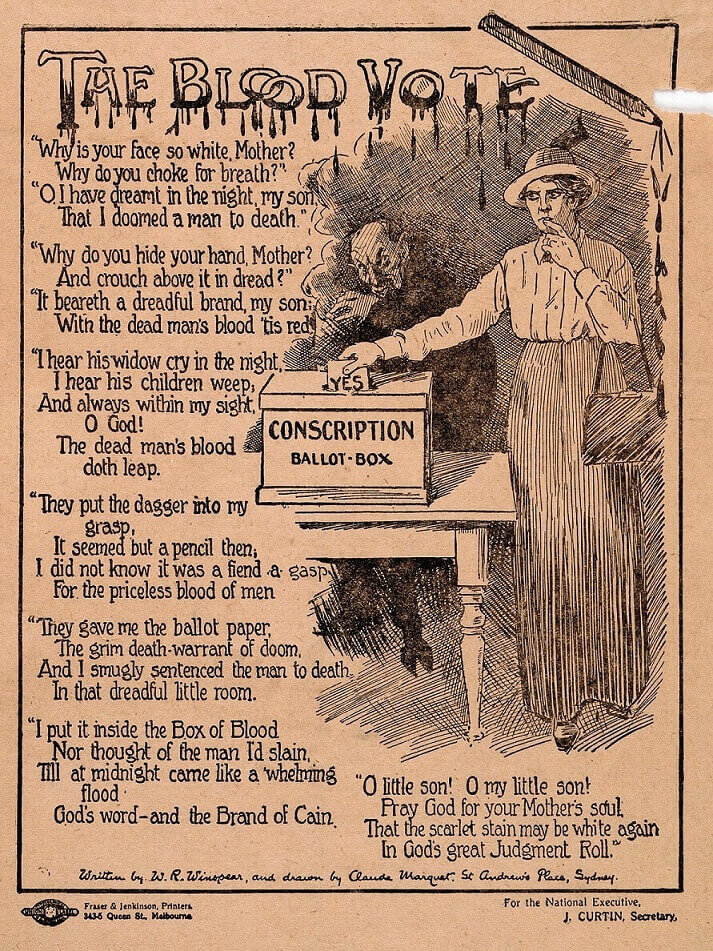
Image courtesy Australian War Memorial
Use of stereotypes
Both sides made use of exaggerated stereotypes. The 'Yes' side created grotesque images of the brutal 'Hun', shown raping and pillaging defenceless women and children, or trampling British 'Liberty' underfoot. One of the most extreme was drawn by Norman Lindsay for the last great recruiting drive. It was controversial even at the time (See '?' below). The labour movement's answer was the bloated figure of the capitalist 'Mr Fat', shown in various guises- as an exploitive industrialist, or as a war profiteer grinding down the hapless worker under the burdens of war (see 'The Burden Bearer' or 'The Referendums') . Marquet also created a female equivalent - the gloriously haughty 'Mrs Toorak' (see 'Mrs Toorak. "What a blessing it's a boy!" ').
Allegorical figures
Both sides had access to a rich tradition of allegorical imagery that was familiar to its audience. The nation of Australia was often presented as a classical goddess, on the model of Britannia (see 'Will You Join Them', or 'Awake Austrlaia'). Liberty could be presented in a similar vein, although the Britannia helmet was then replaced by a soft bonnet, modelled on the phrygian cap - the red cap of Liberty - worn during the French Revolution (see 'Liberty or Slavery'). Alternatively Freedom, Liberty or Democracy might be presented as an heroic masculine figure (see 'Prussianism Defeated' below). Australia might also be presented as a man - even an ordinary working man (see 'Yes or No? Such a Simple Question') - or in more mischievous guise as a cheeky little boy. The Little Boy at Manley was a creation of the Bulletin, later widely adopted by other cartoonists. It was used when the context of the drawing made the use of the dignified goddess inappropriate - as when 'Australia' landed a 'No' egg in the eye of the Prime Minister, Billy Hughes in December 1917 ( see 'Who Threw That Egg?').
The well-known figure of Death, the Grim Reaper, recurred often in conscription imagery. Traditionally Death was drawn as a skeleton, clothed in black and wielding a huge scythe (see 'The Mothers'). Anti-conscription imagery often presented the figure of Death in association with Billy Hughes (see 'The Death Ballot'). In pro-conscription imagery it was associated with the Kaiser or with Germany.
Real people
Caricatures of public figures were the stock in trade of the political cartoonist, although some people made better subjects than others. Billy Hughes was a gift to the cartoonist. A small, slight man (he stood only 5 feet 6 inches or 168 cm tall) with a big head, his gnome-like appearance translated readily into caricature. Labour cartoonists had a field day with Hughes. They drew him as the hunched, wizened gnome scribbling death warrants for conscripts, while the figure of Death loomed in the background ('The Death Warrant'), or as an infant 'Dictator' in a perambulator, wheeled by 'Hughes's Super Police' ('Hatched From a Bad Egg'). They often drew him as the Devil ('Vote Yes and Make This MY Christmas'), or the Devil's assistant ('Sugar-Coating the Devil's Pill), and in other political contexts as the 'Rat' who had betrayed ('ratted on') his Labor colleagues.
The German Kaiser featured prominently in pro-conscription imagery. He was shown lurking at the polling booth, hoping for a 'No' vote ("Before you cast your vote, just think what the Kaiser would like it to be!"), or looming over a woman voter, with half-drawn sword, pointing to 'No' on the ballot paper ('the Voice of the Tempter').
Other protagonists in the conscription debate provided similar grist to the cartoonist's mill. Both Vida Goldstein and Adela Pankhurst were parodied for their feminism and their anti-war stance. By 1916 this was generally limited to the non-labour press (see 'A Day With Adela') , but in the preceding decade the radical press had not scrupled to lampoon them for their feminism on occasion too.
Catholic Archbishop Daniel Mannix was also subject to a barrage of hostile caricature in 1917 in the conservative press. This presented him variously as encouraging sectarianism ('Singed'), disloyal and aiding the cause of the Kaiser ('The Ventriloquist', 'The Temptation') and as a Sein Fein sympathizer ('The Careless Smoker' and 'Sinn Feinism for Australia').
Women and propaganda
Women featured prominently in conscription propaganda. Both sides focussed attention on winning the woman's vote, sometimes creating mirror images of successful posters (see 'Vote Yes/No Mum'). Much of this literature appealed to women as mothers - either to support their husbands and sons by voting Yes and sending reinforcements ('the Crime of Those Who Vote No'), or voting No and saving other mother's sons from the same fate. ('The Blood Vote', 'The Mothers'). Representations of women were also common subjects of propaganda imagery. Female figures, as allegories of countries or as actual women, were murdered and raped by the 'Hun' ('The Danger of Being Too Late'), or shown as heroic modern women supporting their men ('What Can I do: The Women's Big Gun').
In defence of 'White Australia'
Racism also featured in some conscription propaganda. Both sides claimed to be acting in defence of 'White Australia', in material that would now be considered offensive (see 'Keep Australia White: Vote No').
Propaganda material and cartoons featured in the exhibition
Many of the following leaflets, posters and cartoons are featured in the exhibition:
YES or NO? Such a Simple Question
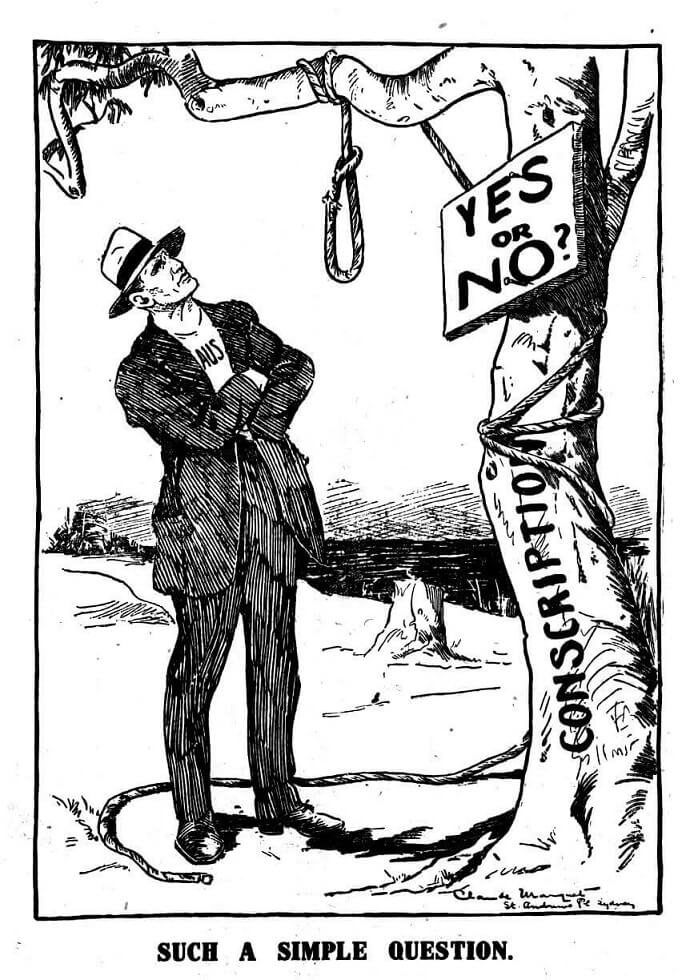
Australia is shown here as a male figure - an ordinary, respectable working man in suit and hat, but no collar and tie. With arms folded he grimly surveys the frayed noose hanging from the Conscription tree and contemplates the 'simple question' he must answer - 'YES or NO?' Marquet's decision to represent the nation as a man on this occasion may have reflected the fact that only men could be conscripted.
Claude Marquet artist,
Australian Worker, 30 November 1917
Courtesy National Library of Australia
Australia has promised Britain
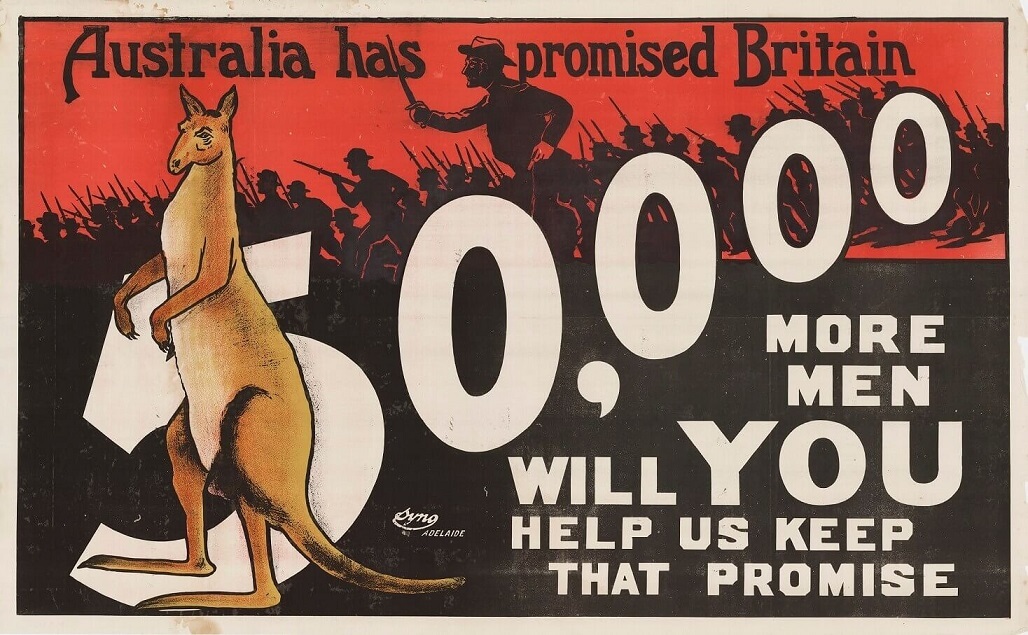
Australia is represented in this recruiting poster by the kangaroo. In the background are Australian soldiers charging the enemy with fixed bayonets. The text asks Australian men to 'keep that promise' to send an additional 50,000 reinforcements to Britain's aid. It is intended to appeal to Australians' loyalty to the Mother Country, but also implies that honour is involved in keeping a promise.
Artist unknown, 1915
Courtesy State Library of New South Wales
Melbourne Answers "NO" To Mr Hughes

This photograph of a large anti-conscription meeting was taken in the Main Hall of the Exhibition Building on 20 September 1916. A note adds that similar crowds were assembled in the Annexes, out of the picture.
Courtesy State Library of Victoria
The Anti's Creed
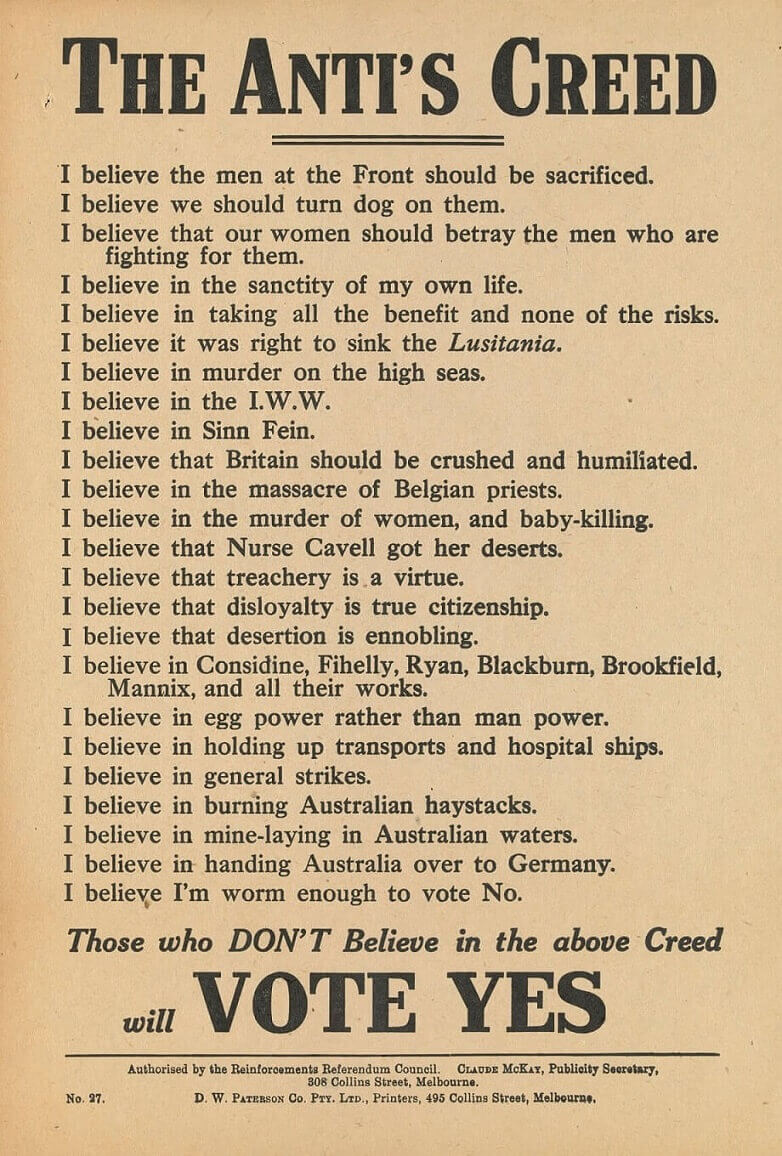
This parody of the Nicene Creed was published by the Reinforcements Referendum Council. It is dated in the Library catalogue as 1916, but seems to refer to some events in 1917. In common with much propaganda at the time, it ascribes exaggerated (and often outrageous) beliefs to the opposing side, to emphasise their disloyalty. Amongst the specific events referenced are:
- the sinking of the Lusitania in May 1915. The Lusitania was a passenger liner sailing from New York to Britain when it was torpedoed by a German submarine and sank with the loss of 1,198 passengers and crew. There was great outrage at the sinking of a non-military vessel, which was seen as further proof of German brutality. The German Government claimed that the Lusitania was carrying a cargo of munitions - later confirmed.
- the 'massacre of Belgian priests', and the 'murder of women and baby killing' probably refers to the widely reported and deplored massacres of civilians by the invading German Army in Belgium in 1914.
- IWW - the Industrial Workers of the World - radical socialists and anti-war campaigners who were vigorously suppressed by the Australian Government.
- Sinn Fein (literally 'We Ourselves') - Irish Nationalists
- Nurse Cavell's 'just deserts'. Edith Cavell was a British nurse, who was famous for assisting the wounded of both sides at the front in Belgium. In 1915 she assisted 200 Allied soldiers to escape from German-occupied Belgium. She was arrested, charged with 'treason' and executed by firing squad, despite world-wide condemnation, on 12 October 1915.
- Considine, Filhelly, etc. All anti-conscription campaigners. Archbishop Daniel Mannix was not an active participant in the anti-conscription debate until 1917.
- 'egg power' - the practice of egg throwing at speakers at meetings, practised by both sides.
- 'general strikes' , 'holding up transports' - probably a reference to the general strike or 'Great Strike' of 1917.
Courtesy State Library of Victoria
The Death Ballot

The gnome-like figure of Prime Minister Billy Hughes is shown busy scribbling. His small stature is emphasised by the tall stool he needs to reach the table, and his rolled-up trouser legs. His wizened scowl is menacing. Death with his enormous scythe stands opposite, placing yet another conscription ballot into Hughes' top hat. In the filing cabinet behind are drawer upon drawer of returns from the 'War Census', collected in September 1915 to identify men eligible for enlistment. They fill an entire cabinet. On 29 September 1916, in advance of the first conscription referendum, a proclamation obliged all single men between 21 and 35 years to report for medical examination to determine their fitness to fight. Hughes was confident of winning the referendum and hoped to have men already trained to send. Exemption courts were established to hear appeals. The exemption courts were notoriously loathe to grant exemptions - hence the tiny number of 'exemptions' shown on the spike above the filing cabinet.
Printed by the No-Conscription Council Campaign Committee, 1917
Courtesy State Library of Victoria
The Voice of the Tempter
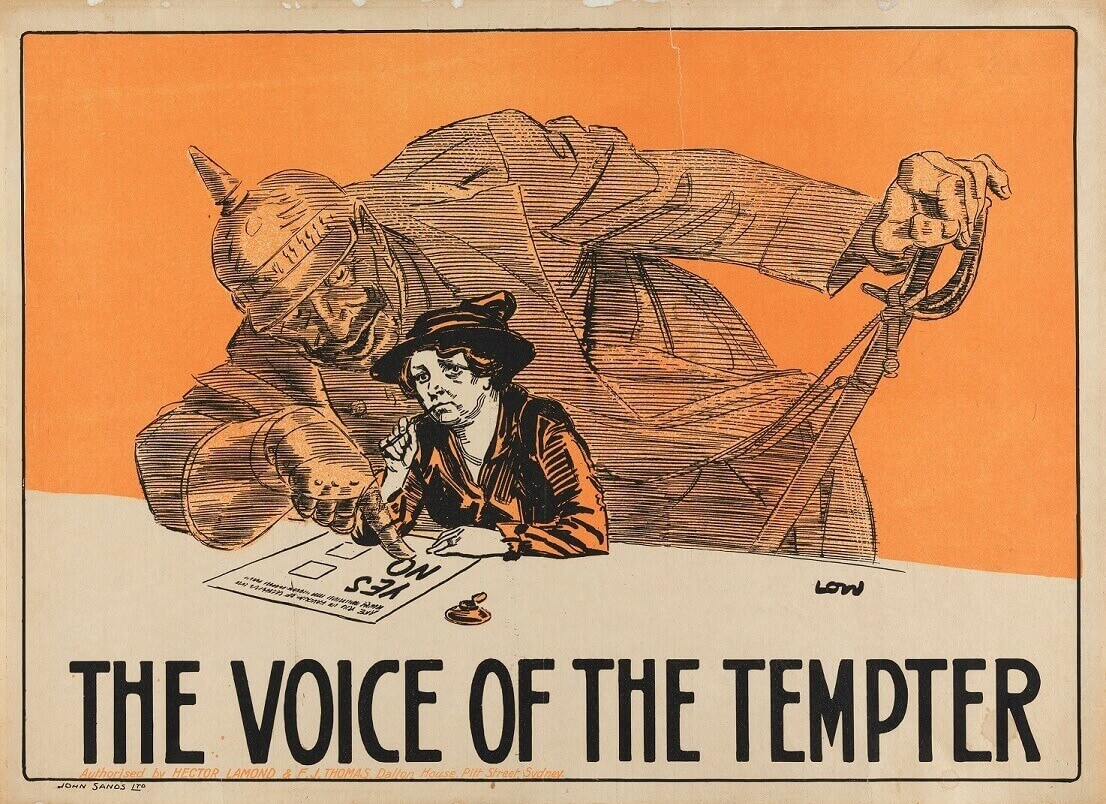
A pro-conscription poster. The giant figure of the Kaiser is shown looming over a woman as she contemplates her ballot paper. His sword is half-drawn, signalling menace and he is pointing to the 'No' box on the ballot. Pro-conscription literature emphasised repeatedly that a vote for 'No' was a vote for the Kaiser and the defeat of Britain. The title suggests an association between the Kaiser's cause and the Devil (the Tempter).
Drawn by David Low
Courtesy Australian War Memorial
The Referendums: Will they Never Come?
Yes, Get Ready for Them in December Next.
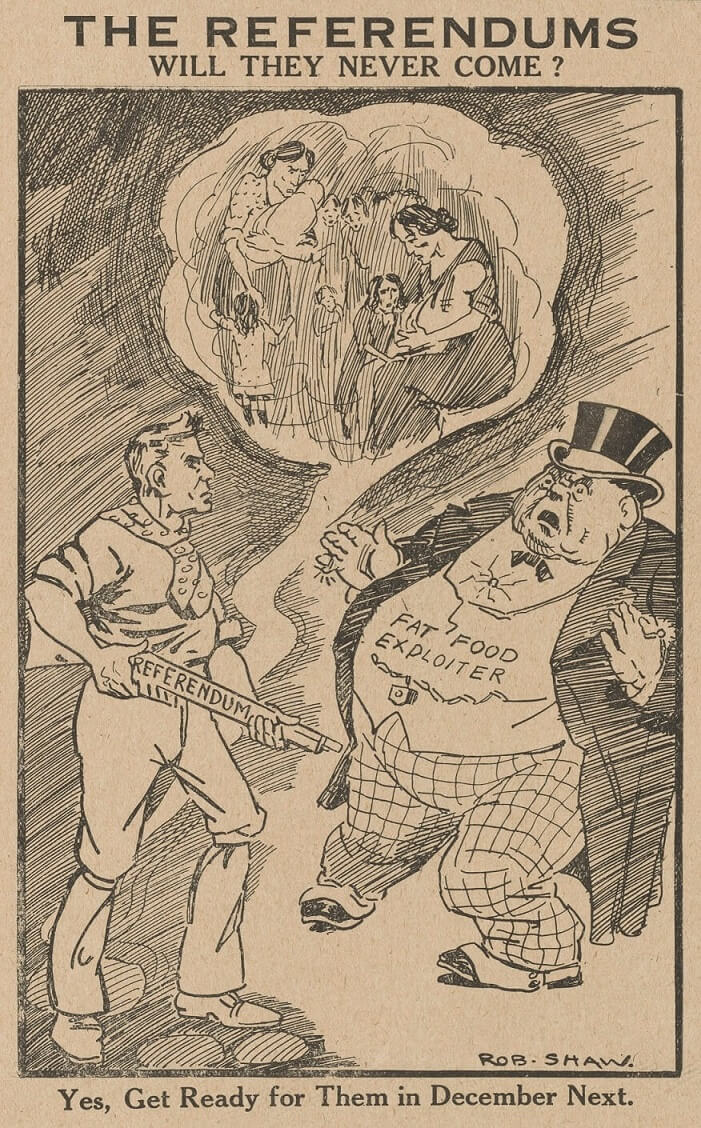
The Referendums signalled in this cartoon were not to do with conscription, but with price control. Wartime inflation was a major preoccupation of the labour movement in Australia throughout the war. Prices rose almost immediately after the outbreak of war and by 1917 it was estimated that the price of food and other essentials had increased by some 28 per cent. Working people had little recourse, because state governments had effectively frozen wages. The Australian Labor Government promised to introduce price control to match wage control, but to do this it required powers ceded by the states through a referendum to amend the constitution. Despite promising to hold a referendum by the end of 1915, the Hughes Government reneged and the referendum on prices was never held - to the deep resentment of the labour movement.
In this cartoon a working man threatens a frightened 'Fat Food Exploiter' with the 'Referendum' rifle. In the background can be seen ghostly figures of starving women and children. The dress of the two male figures further indicates their differing wealth - the working man in trousers tied at the knee, his sleeves rolled up to show determination and a simple scarf at the neck. The bloated figure of the 'Fat Food Exploiter' wears a dress coat, top hat, dress tie and spats - all trappings of the very wealthy. His check trousers are somewhat incongruous and perhaps suggest a 'self-made man' - not a 'true' gentleman. Although the Food Exploiter has all the wealth now, this cartoon suggests that the tables are about to be turned.
Drawn by Rob Shaw
Published in Labor Call 19 August 1915.
Courtesy National Library of Australia
The Burden Bearer
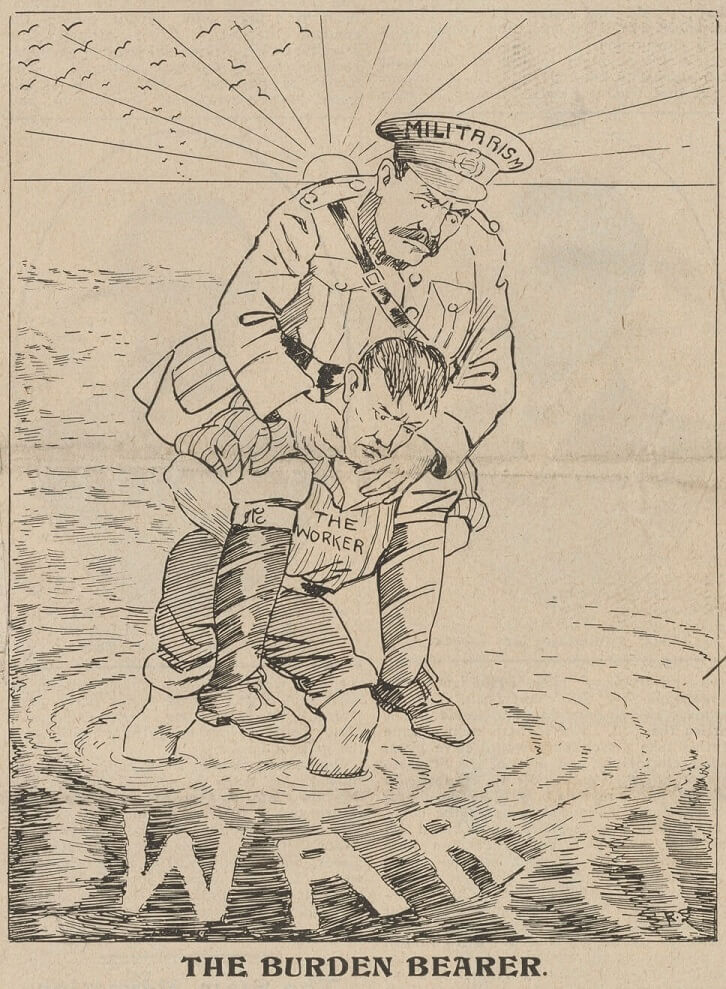
It was a common belief of the labour movement that the burdens of war rested most heavily on workers and the poor. Here a working man ('the Worker') is shown bowed down under the weight of 'Militarism', a large soldier in full uniform. The worker has his trousers and sleeves rolled up (we assume he has bare feet,) as he struggles through the swirling waters of 'War'. In the background is the rising (or setting?) sun of Australia.
Probably drawn by Rob Shaw
Published in Labor Call 5 November 1914
Courtesy National Library of Australia
Mrs Toorak "What a blessing it's a boy! He can work and fight for us."
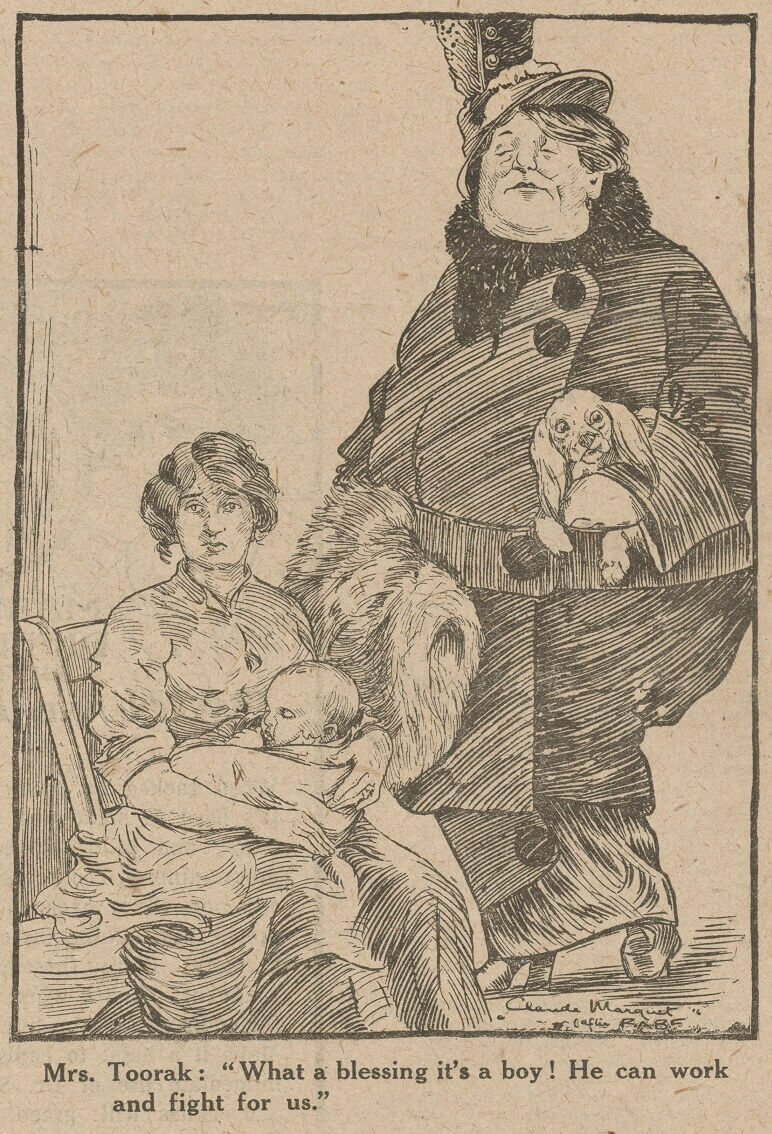
Claude Marquet created 'Mrs Toorak', the female equivalent to the bloated 'Mr Fat'. Since Marquet was working from Sydney by this time, we have to assume that 'Mrs Toorak' was recognisable all over Australia. She stands with wonderful hauteur looming over the simply dressed working mother, who sits with her baby in her arms. Mrs Toorak's elaborate furred coat, her hat with plumes, high heeled boots and her lap dog all signify conspicuous wealth and inactivity. By contrast the poor working mother has only a simple blouse, her sleeves rolled up for the work she must do and an apron over her plain skirt. She sits sadly in a plain wooden chair nursing her infant - destined, Marquet implies, to be industrial and fighting fodder for the rich.
Drawn by Claude Marquet
Published in Labor Call, 23 November 1916
Courtesy National Library of Australia
The Mothers
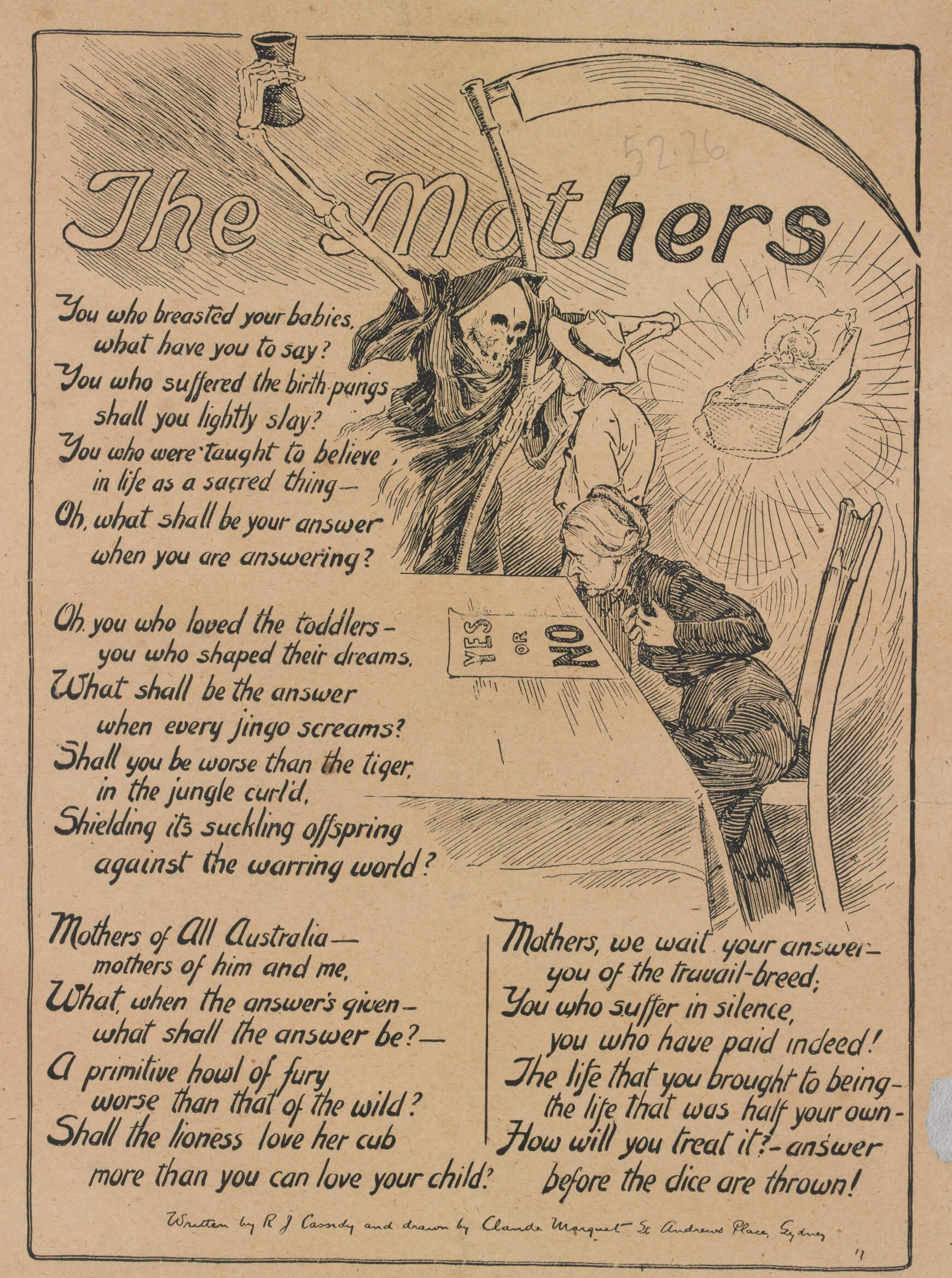
This anti-conscription leaflet calls on Australian mothers to follow their (natural) maternal instincts by voting 'No'. Claude Marquet shows an older woman, hands pressed to her heart, and with an expression of dread as she considers the stark choice 'Yes or No'. In the background is the horrifying figure of Death, wielding his huge scythe and grinning as he holds an hour glass aloft. Time is running out before Death claims the young lad before him. In her thoughts is the infant he once was - or perhaps any innocent male infant who will be affected by her choice.
The poem by R J Cassidy calls on women to be true to their maternal instincts, implying that any woman voting 'Yes' is beneath even the brute beast in the jungle:
'Shall you be worse than the tiger,
in the jungle curl'd
Shielding its suckling offspring
against the warring world? ...
Shall the lioness love her cub
more than you can love your child?'
Written by R J Cassidy and drawn by Claude Marquet
Published by the No Conscription Council Campaign Committee, 1917
Courtesy State Library Victoria
What Can I Do? The Women's Big Gun

This pro-conscription cartoon calls on Australian women to use the power of their vote to support conscription. While they cannot fight in person, it implies, they can still supply the much-needed reinforcements - firing the 'reinforcements Vote' canon, loaded with the huge shell 'Yes'. These are thoroughly modern women, with their shortened skirts and their sleeves rolled up they are ready for action.
Drawn by James Charles Nuttall, 1917
Courtesy State Library of Victoria
Prussianism Defeated: The Glorious 28th
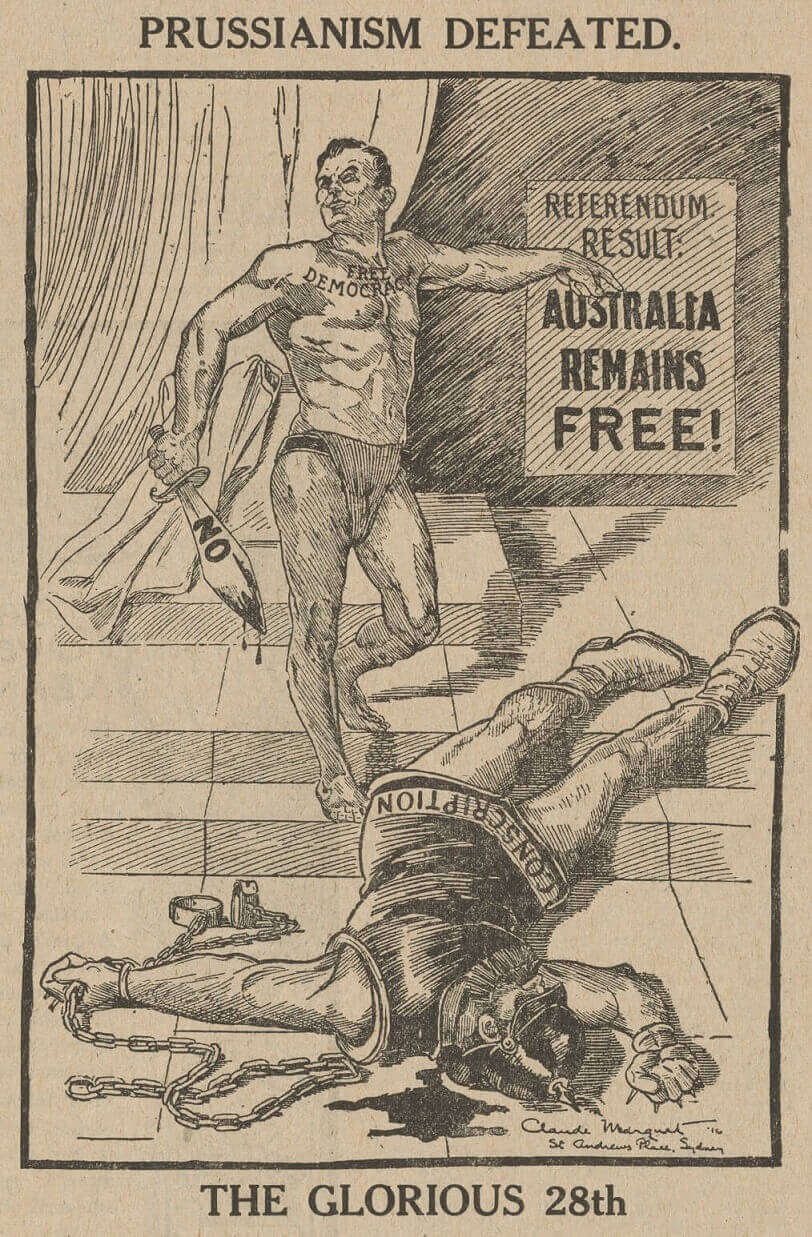
This triumphant cartoon records the defeat of the first conscription referendum, held on 28 October 1916. The masculine, strongly muscled figure of 'Free Democracy', clad only in a loin cloth and armed with a short sword labelled 'No', points in pride towards the billboard 'Referendum Result: AUSTRALIA REMAINS FREE'. Sprawled at his feet is the lifeless figure of 'Conscription'. In contrast to Democracy, 'Conscription' is equipped as a gladiator, with an armoured breastplate and helmet. There are spikes on his fists and trailing from his hand is a set of (open) shackles. A pool of blood lies beneath him, inflicted by 'Free Democracy's' short sword. The term 'Prussianism' was used interchangeably with 'Militarism' and meant military rule Prussian style - conscription, limited democratic rights and the influence of the military in all aspects of the life of the state. Its use here implied that the attempt to introduce conscription in Australia risked destroying the very freedoms Australians were fighting to defend in Europe.
Drawn by Claude Marquet
Published in Labor Call, 16 November 1916
Courtesy National Library of Australia
?
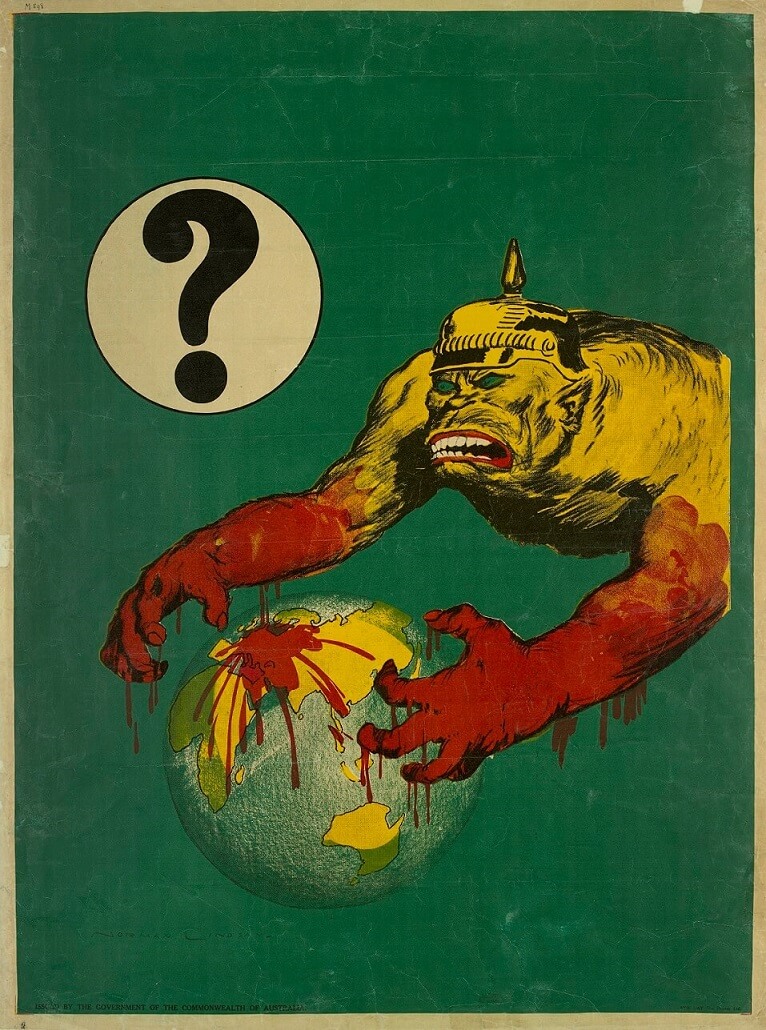
This graphic image was created by Norman Lindsay as one of a series of posters for the last great recruiting drive after the defeat of the second referendum. Lindsay had drawn many such grotesque depictions of the 'Hun' for theBulletin during the war, but this was considered controversial even at the time. Known also as The Ogre or German Monster, it shows a huge monster, with teeth bared and wearing the characteristic German helmet, his blood-drenched hands seizing the globe. Blood drips from his fingers and from Europe towards Australia.
Drawn by Norman Lindsay
War recruitment poster, 1917-18
Courtesy Australian War Memorial
Will You Join Them
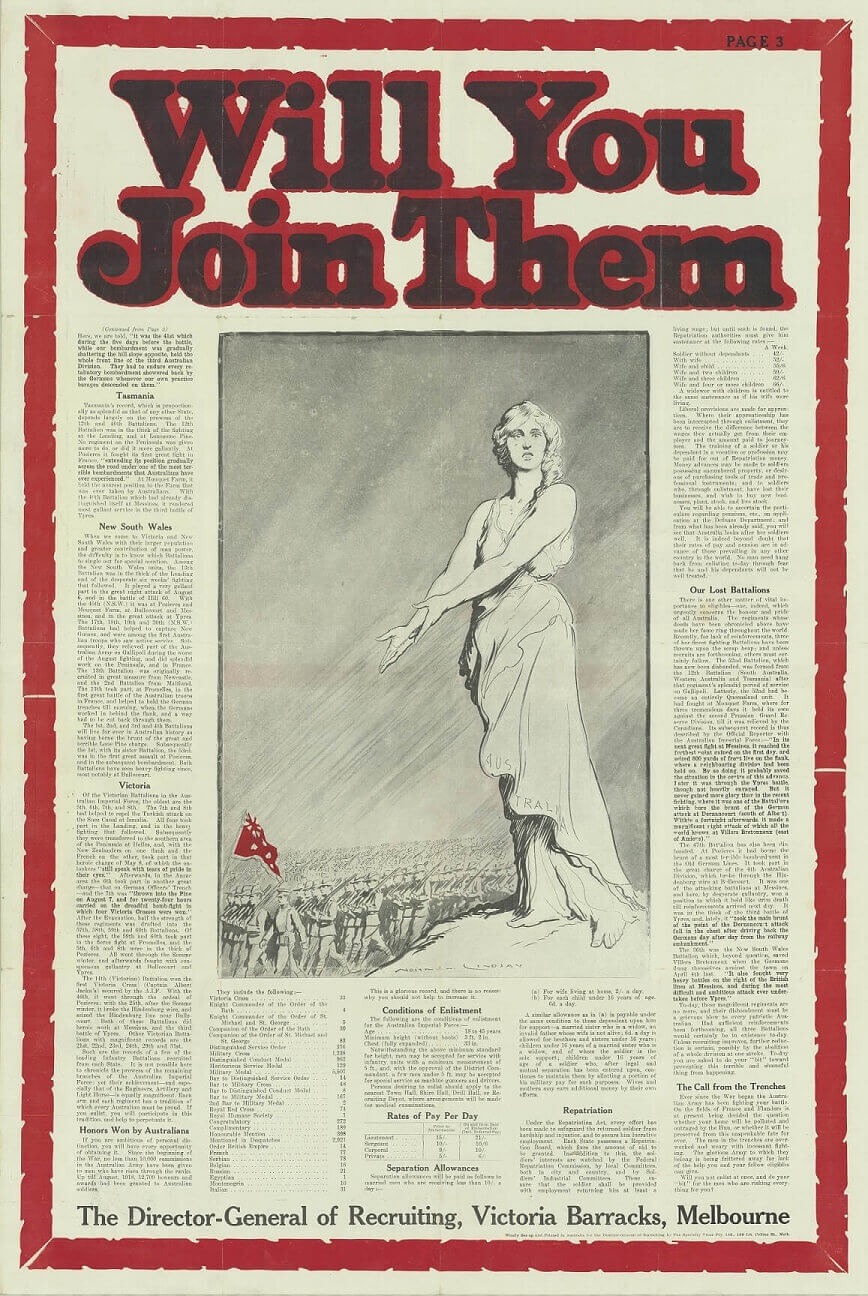
Norman Lindsay created the image for this recruitment poster, issued by the Director-General of Recruiting at Victoria Barracks. It shows a classical 'Australia', unarmed and with no head covering to emphasise her vulnerability. Her open hands indicate serried ranks of infantry, who extend as far as the eye can see, as she entreats the reader, 'Will You Join them'. The flag carried at the head of the troops is the Australian Red Ensign.
The poster includes detailed information about enlistment, including rates of pay, which ranged from 6 shillings per day (once embarked on overseas service) for a private, to 21 shillings per day for a Lieutenant. An additional 'separation' allowance was paid to men earning less than 10 shillings per day, at the rate of two shillings per day for a wife and sixpence per day for each child.
Drawn by Norman Lindsay
Courtesy Public Record Office Victoria
AWAKE AUSTRALIA!
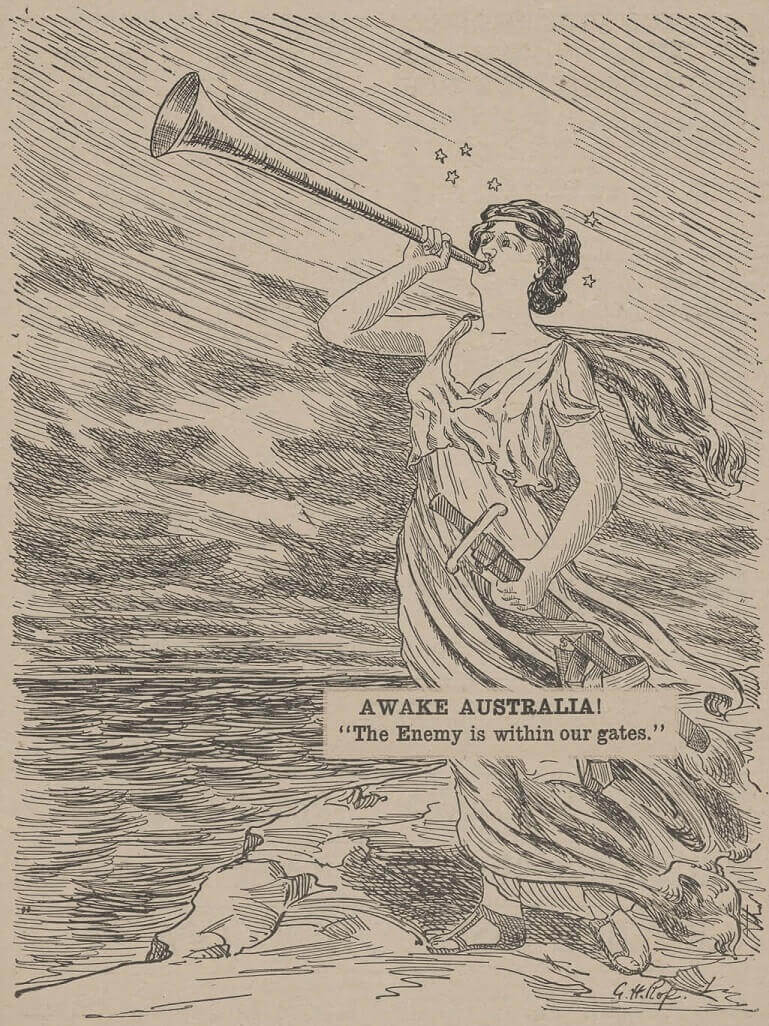
A classical Australia stands at the shoreline, the stars signifying the six states encircling her head. She blows the herald's trumpet to sound the alarm. Australia is not yet armed. She has neither breastplate nor helmet and her sword is held loosely in her hand, still sheathed. Choppy seas and gathering clouds hint at the approaching menace. However the sub-text warns that the enemy is not only over the horizon but 'within our gates'. The 'enemy within' was a common trope of pro-conscription propaganda. It could mean anti-war protestors, anti-conscription campaigners, socialists, the Industrial Workers of the World, the Women's Peace Army, Adela Pankhurst and the food protestors, Archbishop Mannix, the Irish, Australians of German descent, Catholics, or all of the above. As Australia approached the second referendum on conscription, cartoons like this were meant to convey a sense of urgency and peril. They also exacerbated divisions within Australian society.
Probably drawn by G. H. Rofe
Comment and Cartoons, 31 November 1917
Courtesy National Library of Australia
"Vote NO Mum: they'll take DAD next"
"VOTE YES MUM or else they'll take DAD."

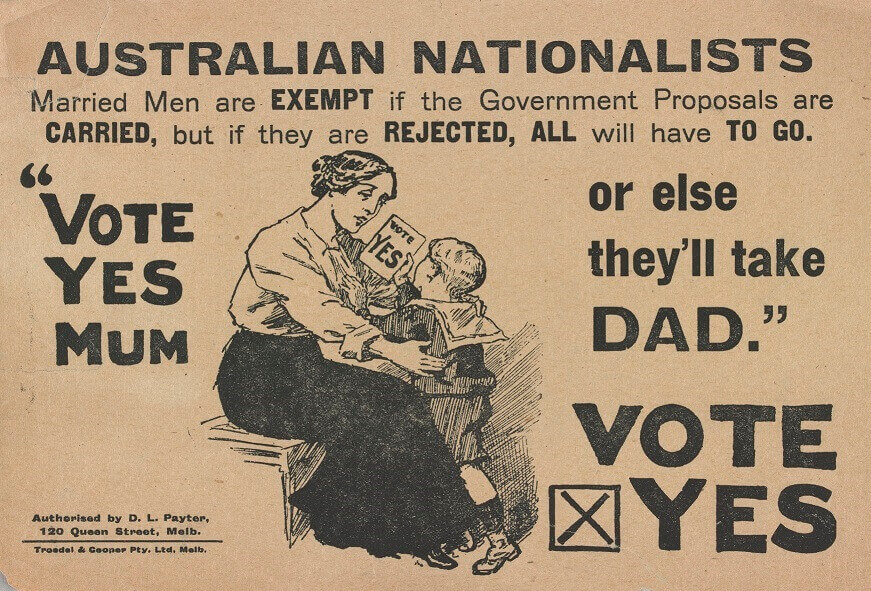
Two almost identical leaflets were produced during the conscription debate, one calling on Mums to vote 'No' and the other to vote 'Yes'. Since the 'No' drawing is signed (initials PL), it seems likely that this one was the original.
Both played on fears that married men with children would be conscripted, although the Australian Government did not plan to conscript married men with families.
Courtesy State Library Victoria
Stand By Your Own
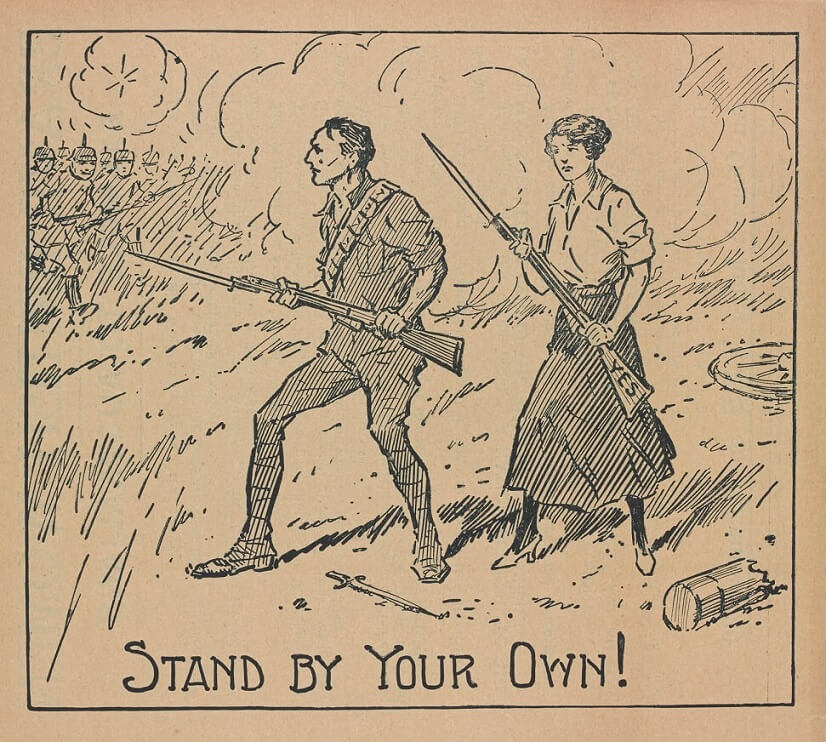
A modern woman, armed with a 'Yes' rifle, supports her uniformed countryman. The advancing German horde are very near.
Unknown artist
Courtesy State Library of Victoria
Hatched From A Bad Egg

Claude Marquet here references Billy Hughes' attempts to stifle debate on conscription. The 'conscription proposal ' itself is the 'bad egg', shown broken open, but with its putrid fumes encircling the figure of 'Premature Militarism'. Hughes himself is shown as a grotesque infant 'Dictator', with a huge sign reading 'SILENCE' fixed to his perambulator. He appears to be thumbing his nose at passers by (the people?). Hughes is wheeled by the huge uniformed figure of 'Premature Militarism', whose spiked helmet points to his links with Prussianism. In his hand he wields a large baton labelled 'HUGHES'S SUPER-POLICE'. The cartoon was drawn in December 1917 and reflects growing anger at the repressive use by the Hughes Government of the War Precautions Act against anti-conscription publications and organisations. The baton-wielding 'Super-police' might also reference the authorities' reaction to the food riots in Melbourne in September 1917, when 400 additional police were sworn in to manage rampaging crowds.
Drawn by Claude Marquet
Australian Worker 14 December 1917
Courtesy National Library of Australia
Keep Australia White
Warning: The views expressed in this leaflet would now be considered offensive.
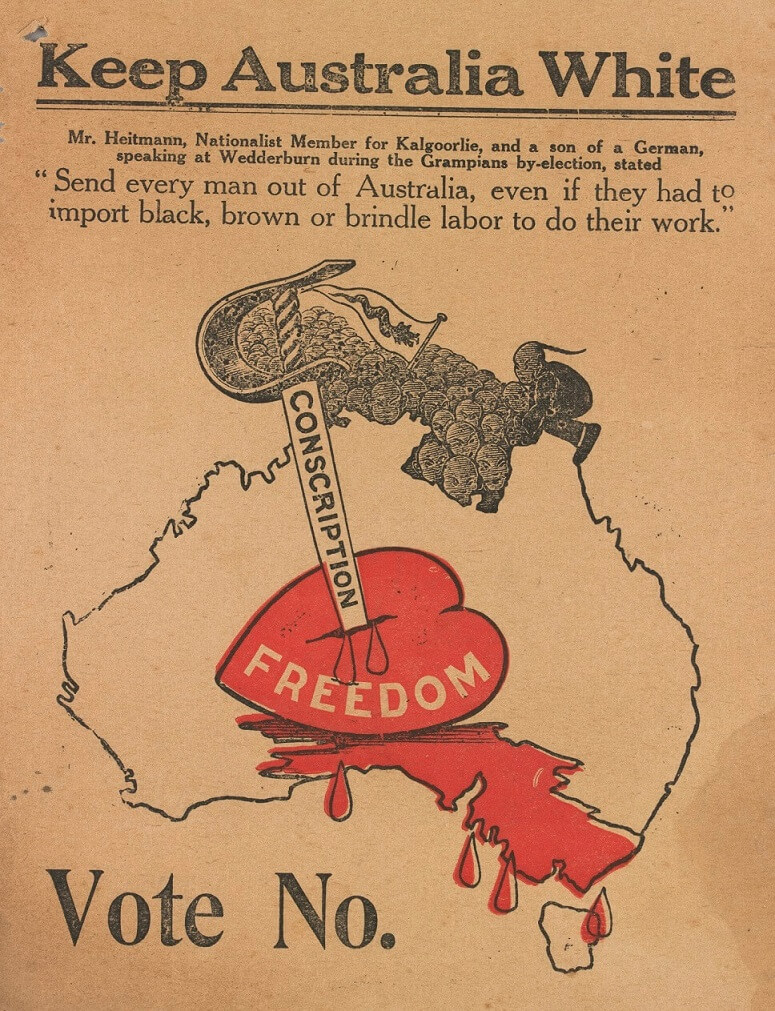
This anti-conscription leaflet reflects a fear commonly voiced by the labour movement that employers would exploit any labour shortage caused by conscription to import cheap foreign labour and drive down wages for all workers. They feared in particular the introduction of 'Asiatic' and 'coloured' labour, by which they usually meant Polynesians or 'Kanacks'. But the same exclusions could apply to others. In 1916 the arrival of a group of Maltese refugees caused controversy and widespread protests from a nervous labour movement.
Such fears were not without foundation. This leaflet cites a speech reputedly delivered by the Nationalist MP Edward Heitmann, whose German family origins were also emphasised: "Send every man out of Australia, even if they had to import black, brown or brindle labor (sic) to do their work."
The graphic shows a map of Australia, with the 'Freedom' at its heart pierced by the sword of 'Conscription', so that it bleeds over the south-eastern states. Pressing to the north is a horde of Chinese figures, with their dragon flag flying.
Murderers!
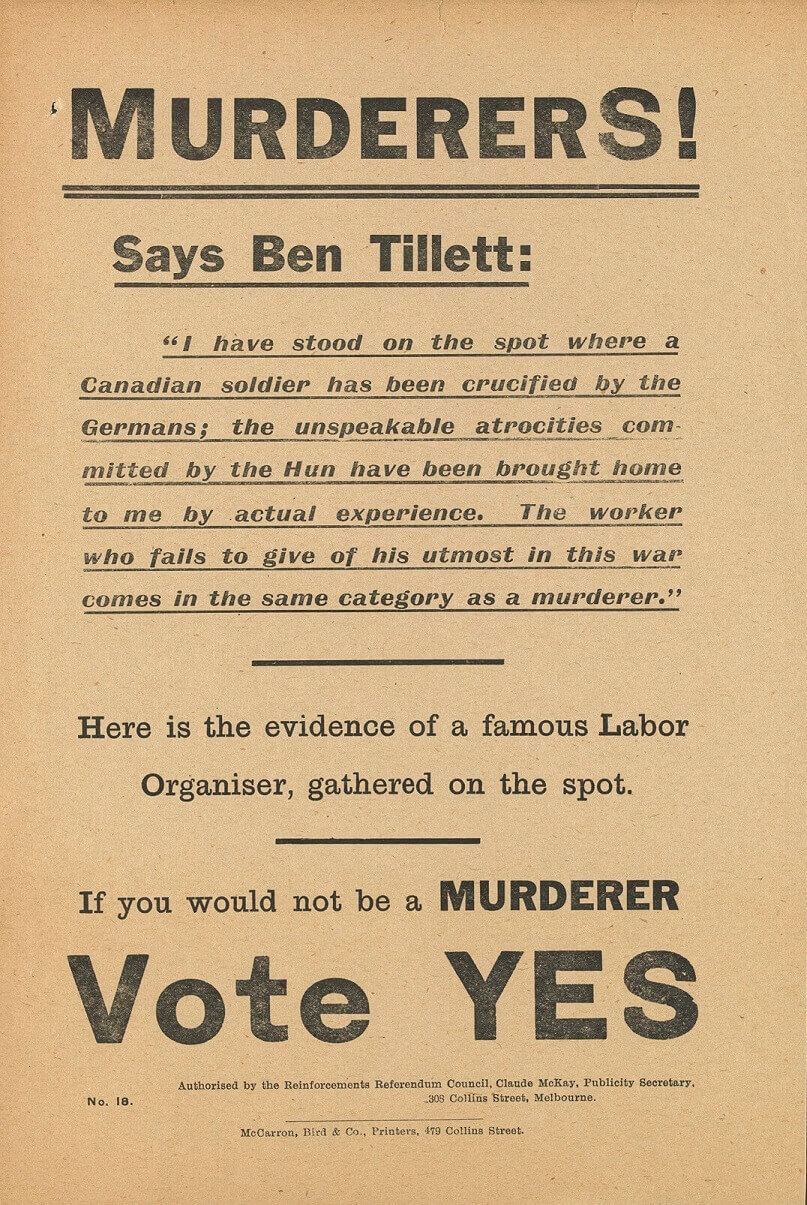
This leaflet was intended to appeal to Australian workers. It quotes the words of a prominent British socialist and unionist, Ben Tillett, an organiser of the Dockers Union. Tillett supported the war, unlike some fellow socialists who became conscientious objectors.
OF COURSE, WE'LL ALL BE IN THE SAME BOAT.
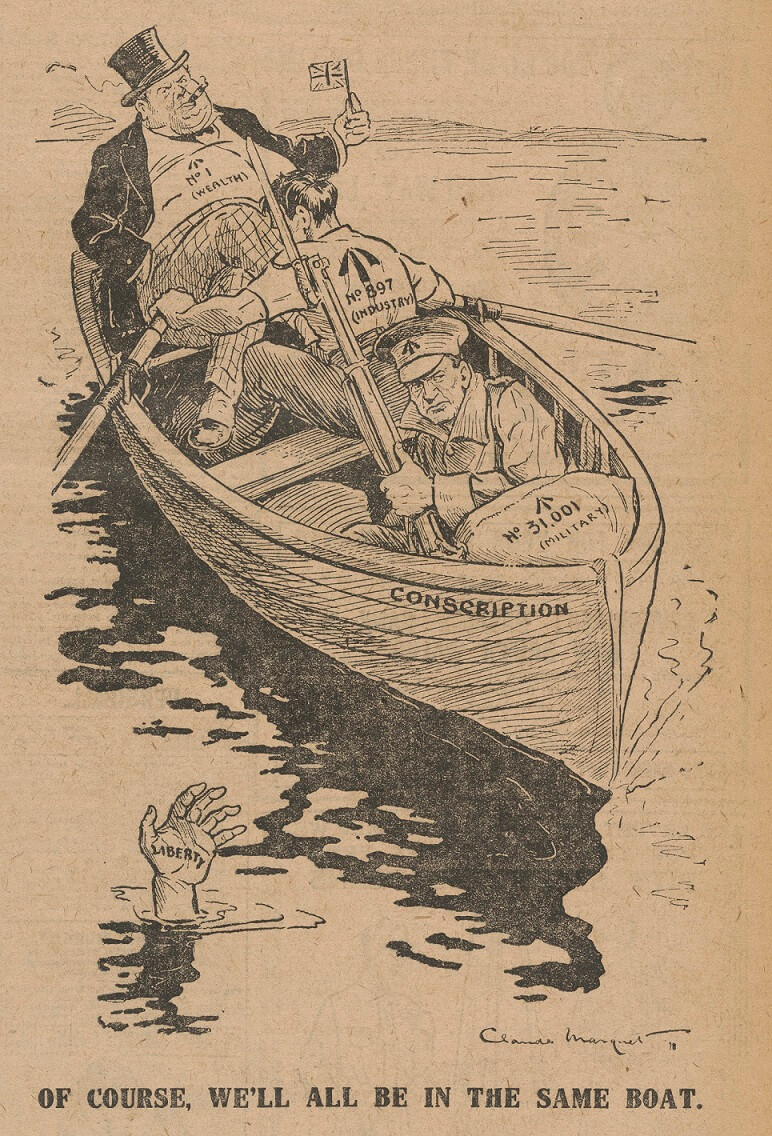
This anti-conscription cartoon presents the familiar figure of Mr Fat, here seated in the prow of the 'CONSCRIPTION' boat, waving his Union Jack. His expanse of stomach is labelled with the Government brand (the broad arrow) and 'No 1 (WEALTH)'. His top hat and cigar signal his leisured status. Not for him the hard work of rowing, which falls instead to 'No 897 (INDUSTRY)', while recruit 'No 31,001 (MILITARY)' mounts guard with his rifle and fixed bayonet. Only the hand of 'LIBERTY' can still be seen above the water, desperately appealing for rescue.
Drawn by Claude Marquet
Australian Worker 8 November 1917
Courtesy National Library of Australia
Polling Booth
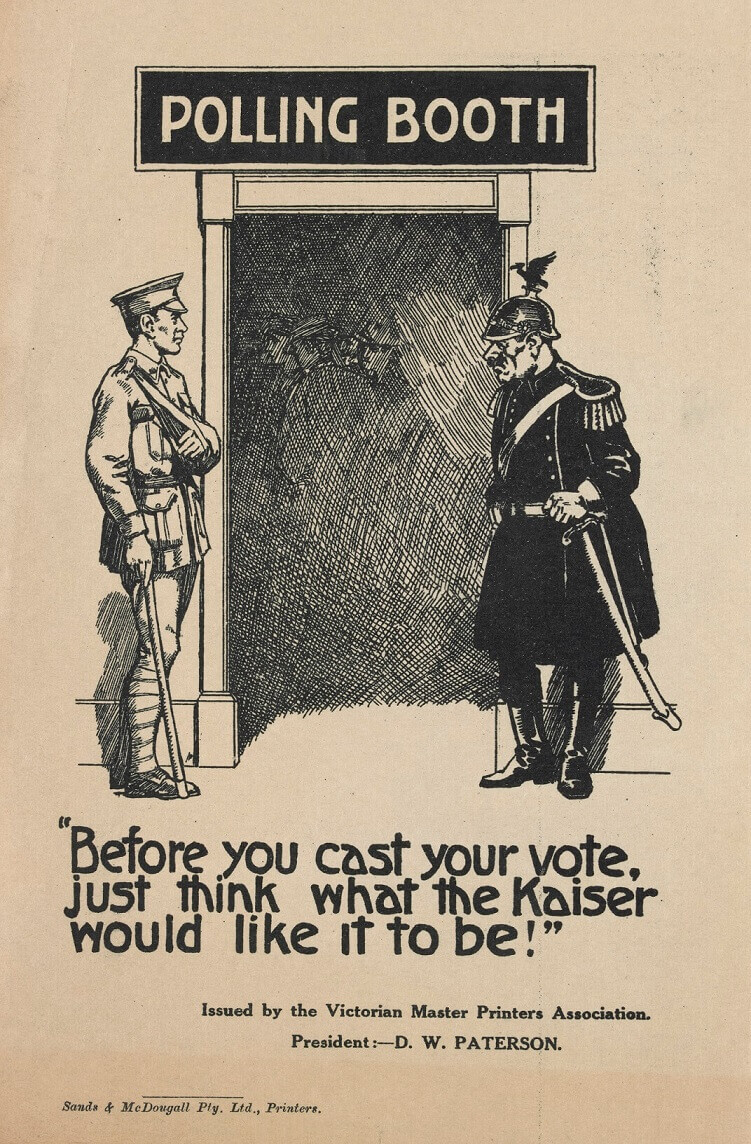
This leaflet for the 'Yes' side reminds voters of their patriotic duty to support those wounded soldiers and defeat the Kaiser. It was issued by the Victorian Master Printers Association in 1917.
Courtesy State Library of Victoria
SUGAR-COATING THE DEVIL'S PILL
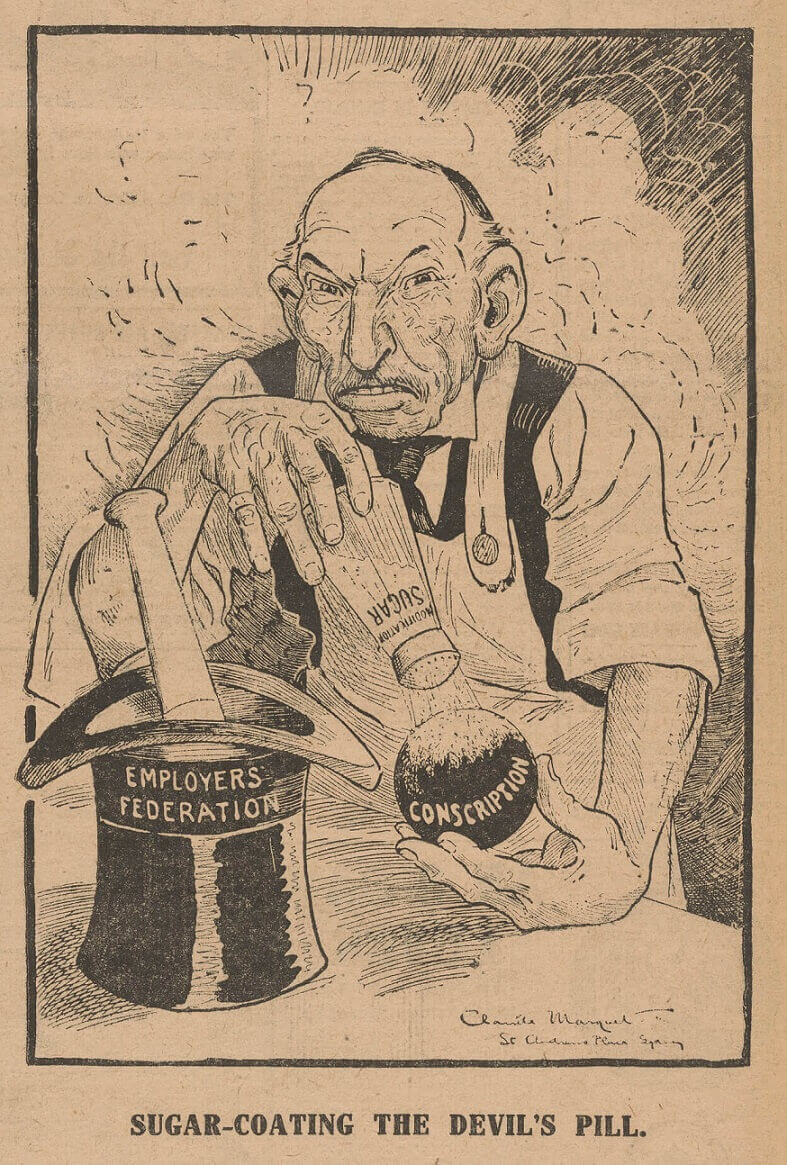
In this anti-conscription image labour cartoonist Claude Marquet presents Prime Minister Billy Hughes as a demonic confectioner, 'sugar-coating' the (very large) 'Conscription' pill to mask its bitter taste. The sugar sifter is labelled 'Modification Sugar'. Hughes has been grinding the ingredients for the pill in the 'Employers' Federation' top hat, again suggesting that the government is working in the interests of employers against workers.
Drawn by Claude Marquet
Australian Worker 15 November 1917
Courtesy National Library of Australia
The Crime of those who Vote "NO!"

A pro-conscription leaflet, accusing those men and women who contemplate casting a 'No' vote of disloyalty and betrayal of the men at the front. George Dancy presents both male and female anti-conscription voters thrusting daggers into a desperate 'Australian Volunteer', while a grinning Kaiser Wilhelm looks on from his palace balcony in Potsdam. The cartoon quotes Prime Minister Billy Hughes' Manifesto to women voters in 1916: "Shall I, by my vote, plunge a dagger into the heart of ...my children at the front, my brother or my husband?"
Drawn by George Dancy
Originally published in Melbourne Punch 12 October 1916 and re-printed by the Town Clerk of Port Pirie in South Australia
Courtesy National Library of Australia
THURSDAY'S "NO" STORM

This cartoon, published on the day of the second conscription referendum on 20 December 1917, predicts the victory of the 'No' vote. It shows a tearful Billy Hughes trying to shelter from the storm of 'No' ballots under a big black 'Conscription' umbrella.
Drawn by Claude Marquet
Australian Worker 20 December 1917
Courtesy National Library of Australia
Vote "Yes" and make this MY Christmas.

One of the most graphic of Claude Marquet's drawings of Billy Hughes as the Devil. The Devil points his bony finger at the ballot box labelled '20th', (referencing the date of the approaching vote,) while a broken Christmas bell lies in the foreground.
Drawn by Claude Marquet
Australian Worker 17 December 1917
Courtesy National Library of Australia
Wholesale Slaughter
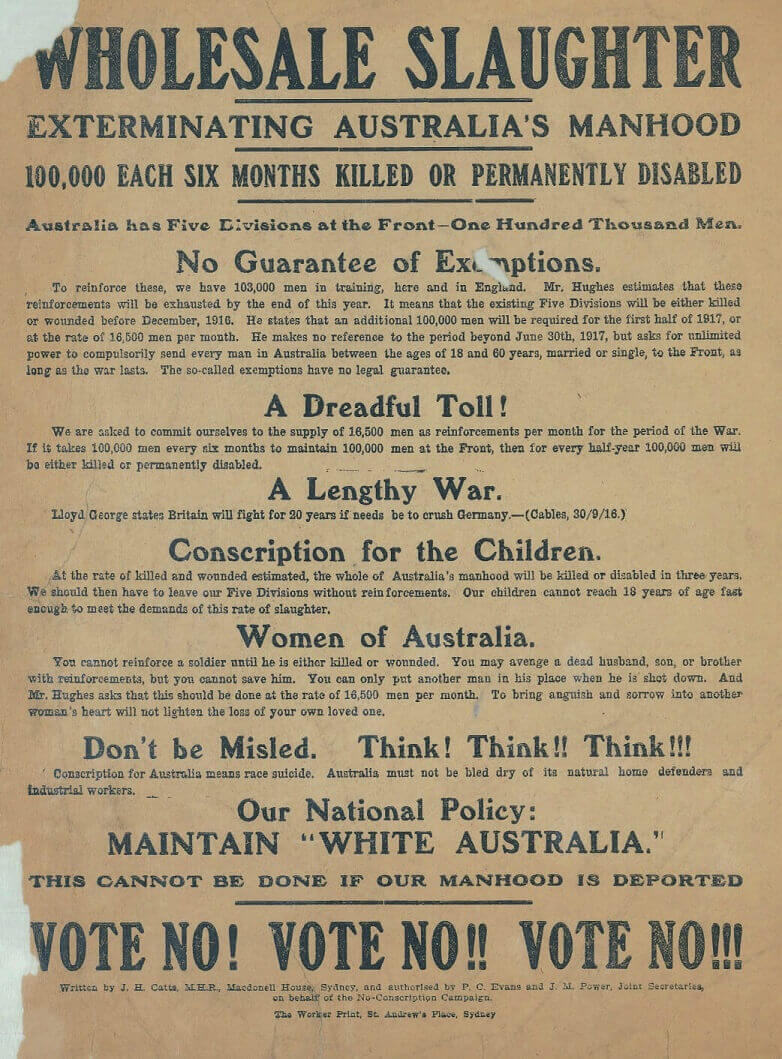
An anti-conscription leaflet pointing to the 'wholesale slaughter' on the battlefield and predicting that the entirety of 'Australia's manhood' would not be enough to produce enough reinforcements.
1916
Courtesy State Library of Victoria
"NO, for ME, Daddy!"

An infant 'Australia Junior' calls on his 'Daddy' to vote 'No'.
Drawn by Claude Marquet
Australian Worker 23 November 1917
Courtesy National Library of Australia
"PUT 'EM'UP!"

A red-nosed, bloated 'Mr Fat' ('Capital'), armed with his 'Conscription' sword, threatens a severely wounded 'Labor'. Another cartoon suggesting that the burdens of war rested unfairly on workers.
Drawn by Claude Marquet
Australian Worker 15 November 1917
Courtesy National Library of Australia
The Blood Vote

The Blood Vote was one of the most effective leaflets produced by the anti-conscription campaign. More than one million copies were printed and distributed and many survive in collections today. It was drawn by labour artist Claude Marquet to accompany a poem that at the time was attributed to the socialist W.R. Winspear, at the request of its actual author, E.J. Dempsey, who at that point was working for the pro-conscription newspaper the Evening News.
The image shows a woman hesitating as she places her 'Yes' vote in the 'Conscription Ballot-box'. Lurking in the background is a demonic Billy Hughes ('the fiend'). Blood drips from the title of the poem and from the pencil used to mark the ballot paper. The poem emphasises the dreadful responsibility that rested on the ballot - the potential to send a man to his death on the battlefields. It also implies that married men would be conscripted, although this was not the government's intention at the time. The leaflet was issued by John Curtin, later Labor Prime Minister. Curtin co-ordinated the anti-conscription campaign for the labour movement.
"Why is your face so white, Mother?
Why do you choke for breath?"
"O I have dreamt in the night, my son,
That I doomed a man to death."
...
"I hear his widow cry in the night,
I hear his children weep,
And always within my sight, O God!
The dead man's blood doth leap ."
The Voice of Germany: Where Germany Prays
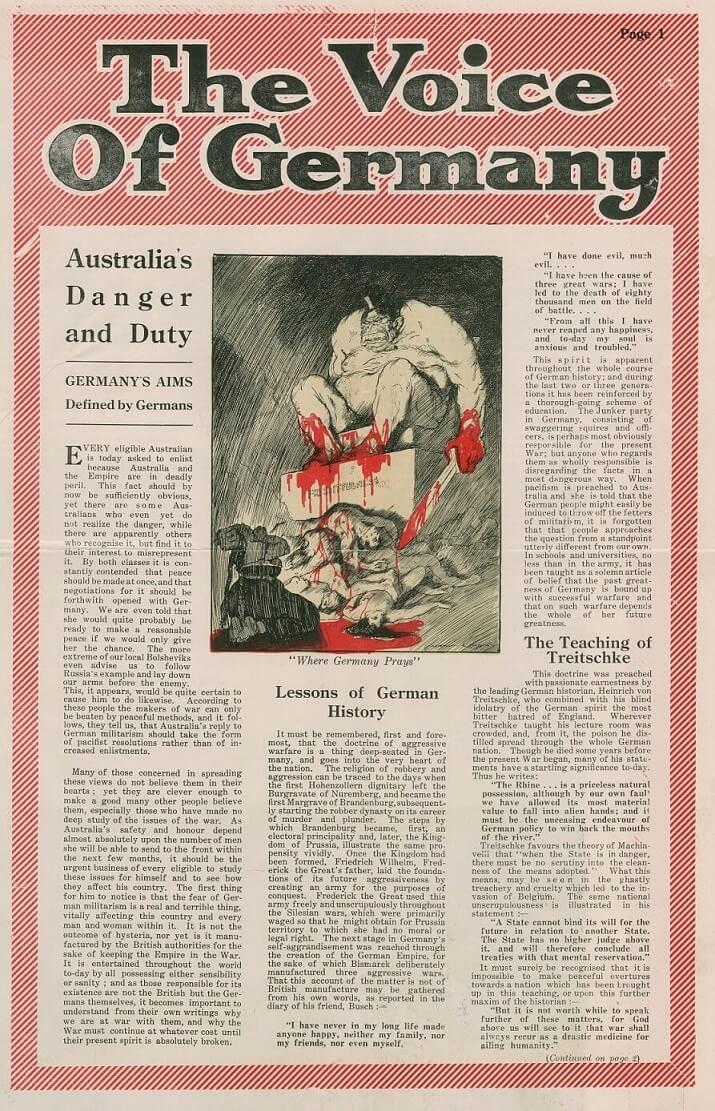
A three page propaganda leaflet issued by the Director-General of Recruiting in Victoria after the defeat of the second referendum on conscription. The lengthy text justifies Britain's continuing war against Germany and pleads with Australian men to enlist. It rejects the claims of Australian pacifists (here called 'local Bolsheviks'), who were pressing for a negotiated peace, arguing that Germany's militarist history made peace impossible. There are graphic Norman Lindsay illustrations on each page.
Page one shows the grotesque image of a brutal 'Hun', similar to many such images Lindsay created. It shows the grossly-fat figure of an ogre, naked apart from a helmet and sandals. His blood-drenched sword, hands and feet drip blood onto the parody of an alter, with the word 'FRIGHTFULNESS' engraved on its face. Piled at the base of the alter in pools of blood are slaughtered men. A German matron worships the figure in the foreground.
Page 2 is titled 'The Gospel of Frightfulness' , subtitled 'The Gospel that Murders Children and Women'
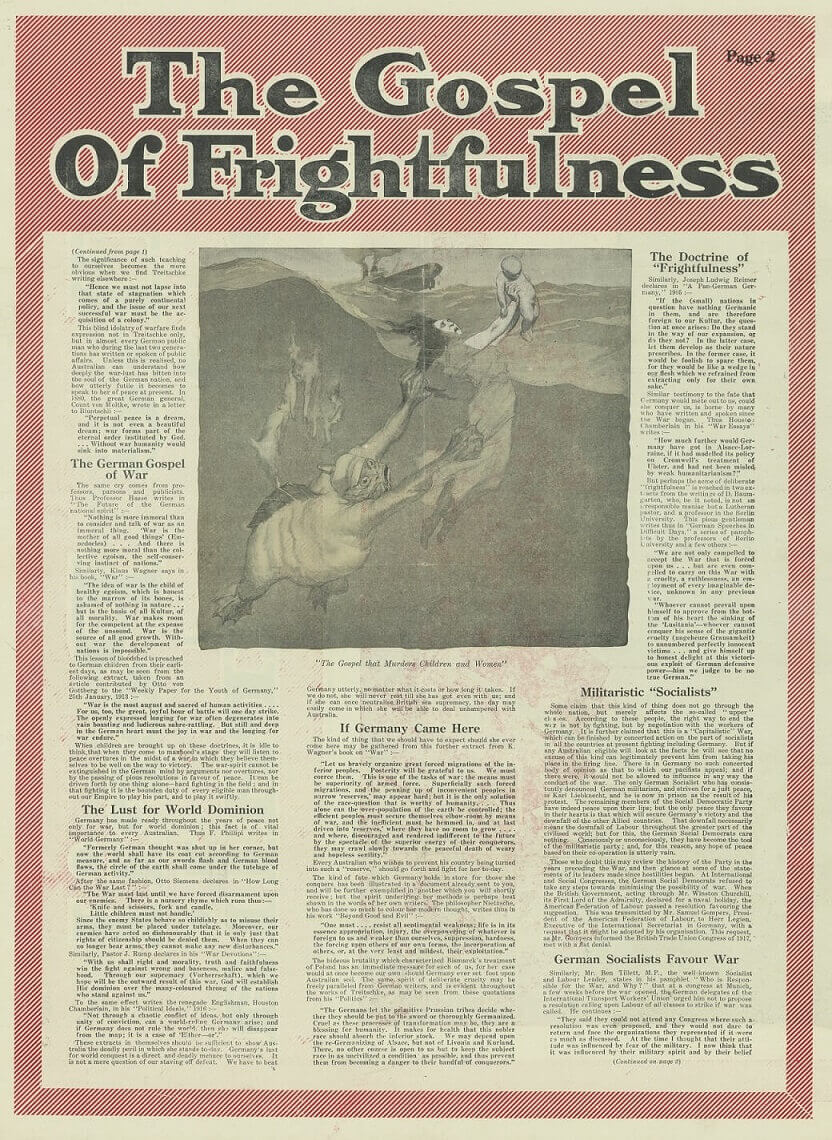
It shows a horrible webbed sea creature, with the large mouth Lindsay favoured in his ogres and German helmet, dragging a woman under the waves by her hair. She tries frantically to hold a naked baby above the waves, although the baby appears already dead. A submarine rests in the background. This is an especially disturbing image, as it was no doubt intended to be. The text continues to outline Germany's bloody militarism and speculates about the outcome 'If Germany Came Here'.
Why We Must Win The War
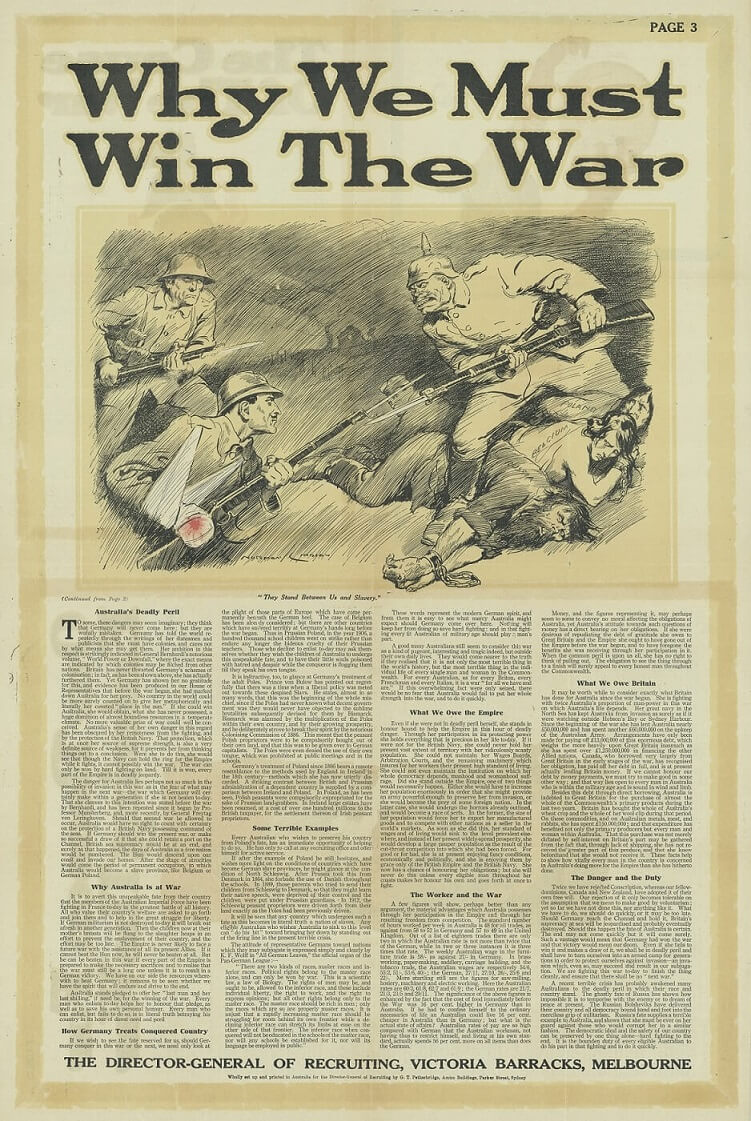
The final page of this extraordinary paper moves to Australia. 'Australia's Deadly Peril', 'Why Australia is at War', What We Owe the Empire' and 'What We Owe Britain'. It also includes a paragraph on 'The Worker and the War', which argues that Australian workers are much better off than workers in Germany. It concludes by warning Australians of their certain fate should Britain lose the war. Ironically, it also argues 'We are fighting this war today to finish the thing cleanly, and ensure that there will be no "next war". Sadly, that was not to be the case.
Lindsay's final illustration shows the German ogre trampling on the shackled bodies of 'Russia', 'Belgium' and 'Poland'. With bayonet fixed he is bearing down on a soldier, who fights on despite a bleeding wound on his hand and his arm in a sling. Another desperate soldier is coming to his aid. The subtext reads 'They Stand between Us and Slavery'.
Illustrations by Norman Lindsay
Courtesy Public Record Office Victoria
Who Threw that Egg?
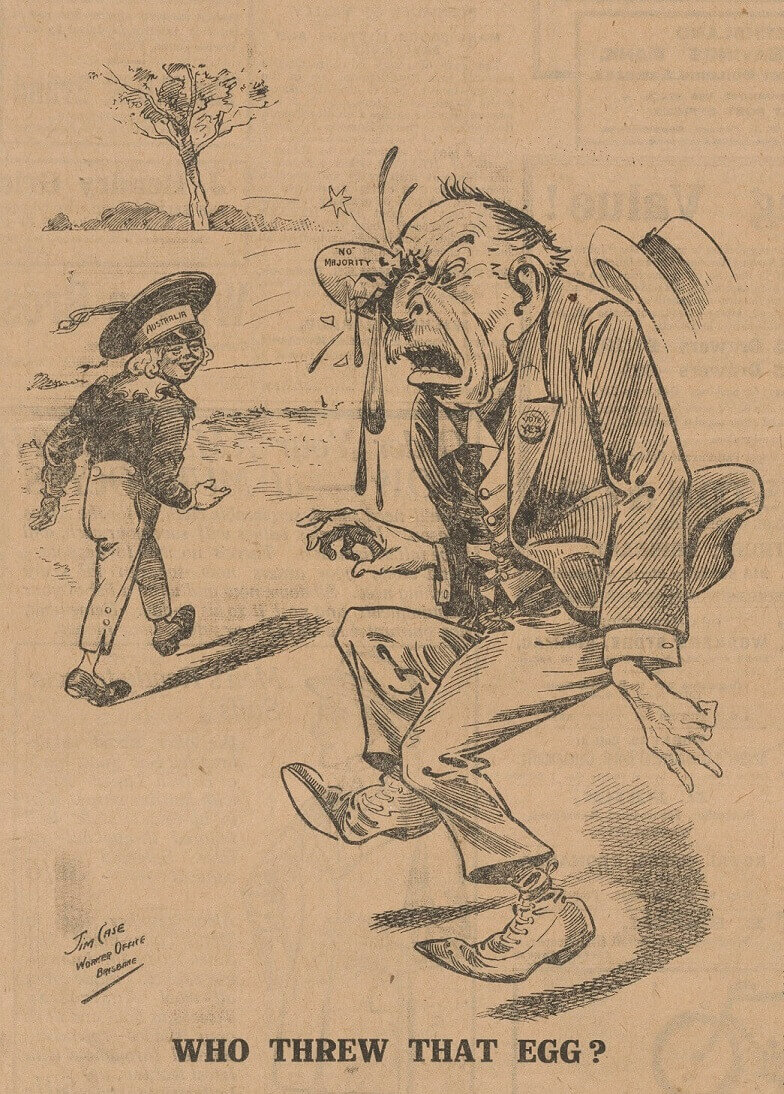
This mischievous cartoon marks both the defeat of the second conscription referendum and a real incident, in which Billy Hughes was pelted with eggs in Brisbane. An enraged Hughes strode into the crowd shouting 'Who threw that egg?' When the Queensland Police refused his order to arrest the culprit, arguing that they were answerable only to the state government (which opposed conscription), Hughes resolved to create a federal police force.
The image shows a discomfited Billy Hughes, hit full in the eye with a 'No Majority' egg. His 'Vote Yes' badge is clearly seen on his lapel and he has lost his hat. A laughing 'Australia' (the Little Boy at Manley) is making his getaway.
Drawn by Jim Case
Australia's Pioneer Co-operative Labour Journal, 27 December 1917
Courtesy National Library of Australia
A Day with Adela
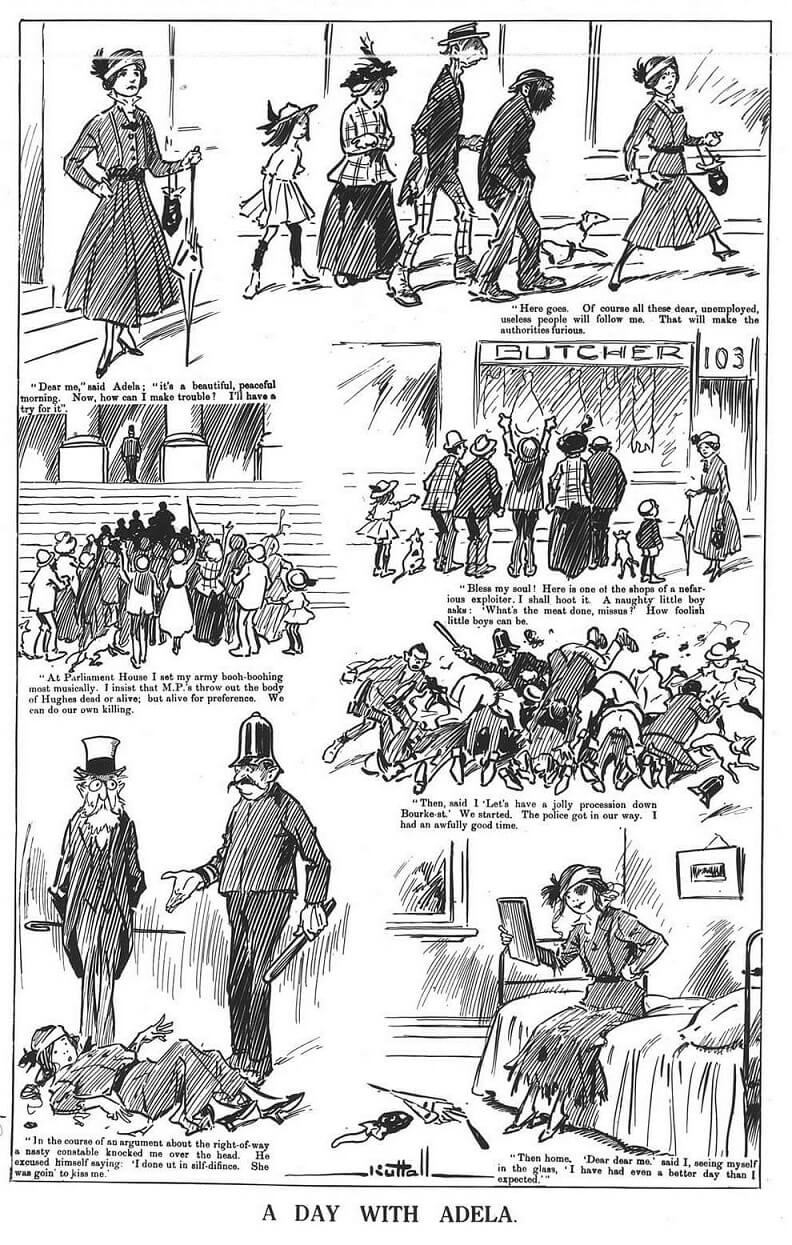
Punch was famous for its satirical journalism and for poking fun at public figures. This cartoon sequence makes light of the widespread public anger and almost daily demonstrations against high food prices in 1917. Adela Pankhurst was one of the consistent organisers of the meetings and marches. She is shown here as a modern, fashionable young woman, who is only out looking for excitement. Her followers are witless and easily manipulated. Adela herself is shown enjoying the dust-up with the police and congratulating herself at the end of the day as she inspects her tattered appearance: '' 'Dear, dear me', said I, seeing myself in the glass. 'I have had even a better day than I expected.' " The tone is patronising, the intention to belittle not only the commitment of those leading the food campaign, but those taking part as well. Adela's feminism is also satirised in the sequence with the policeman (also a figure of fun), whose excuse for knocking her down is 'I done ut in silf-difince. She was goin' to kiss me.'
Drawn by James Charles Nuttall
Melbourne Punch 6 September 1917
Courtesy National Library of Australia
Singed
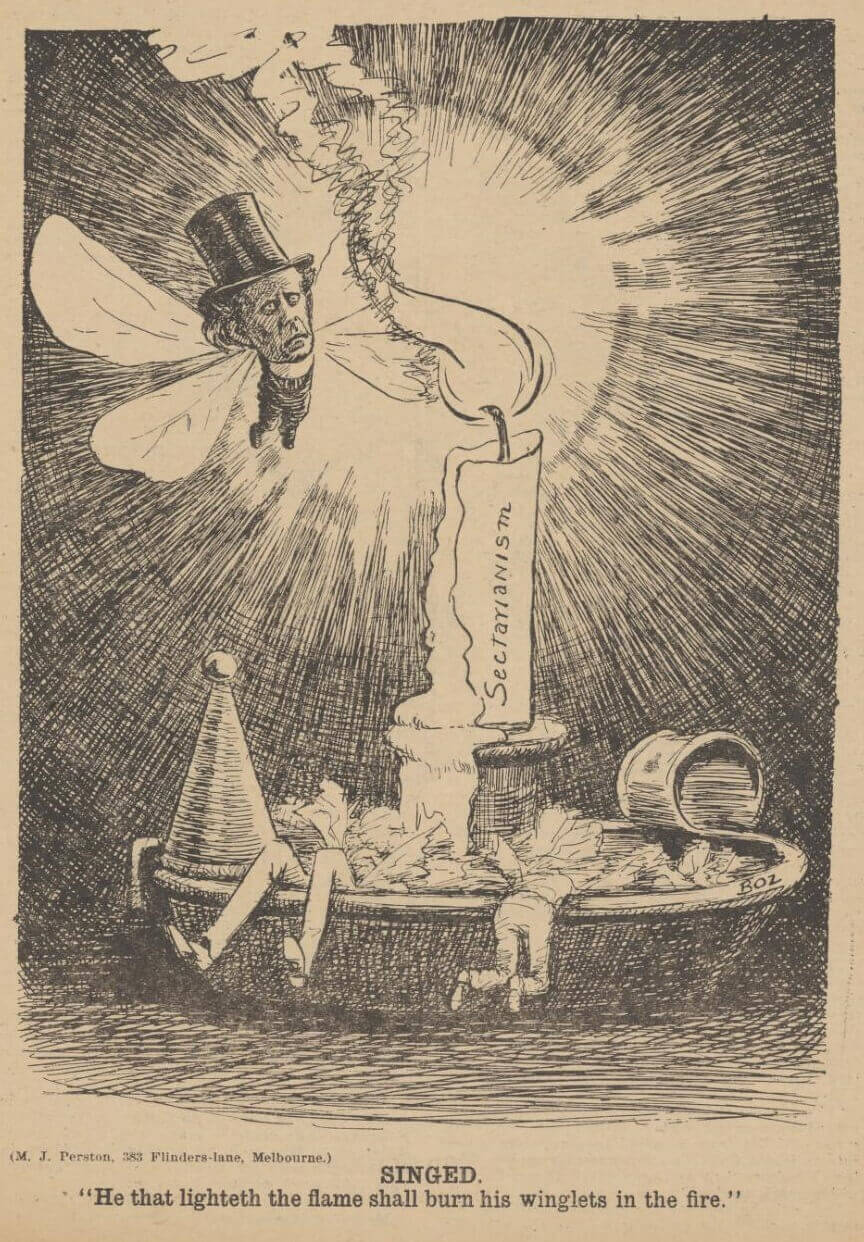
This cartoon suggests that Catholic Archbishop Daniel Mannix has encouraged sectarianism by his support of the anti-conscription cause. Mannix is shown here as a fly that has flown too close to the candle flame ('Sectarianism'). The sub-text reads: "He that lighteth the flame shall burn his winglets in the fire."
Drawn by 'Boz' (Miss Annie Hope Campbell)
Comment and Cartoons,14 December 1917
Courtesy National Library of Australia
The Ventriloquist
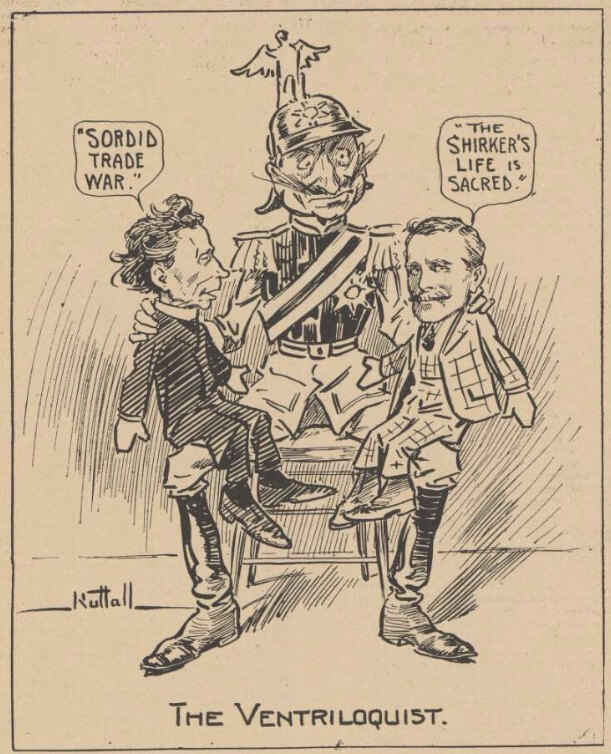
Kaiser Wilhelm is shown here with two ventriloquist dummies on his knees- Catholic Archbishop Mannix on his right knee and the Labor leader Frank Tudor on his left. In the bubble above Mannix's head is a comment attributed to him describing the First World War as a 'Sordid trade war'. Tudor was a principled opponent of conscription. A member of the Congregationalist Church, which included many pacifists, he had opposed conscription from the beginning and resigned from Hughes' cabinet over the decision to hold the referendum. He became Labor leader after Hughes' expulsion. His pacifism is translated unkindly here to 'The Shirker's life is sacred', by implication at the expense of serving soldiers. This cartoon implies that both men were effectively aiding the cause of Germany through their public statements.
Drawn by Charles Nuttall
Comment and Cartoons, 7 December 1917
Courtesy National Library of Australia
The Temptation
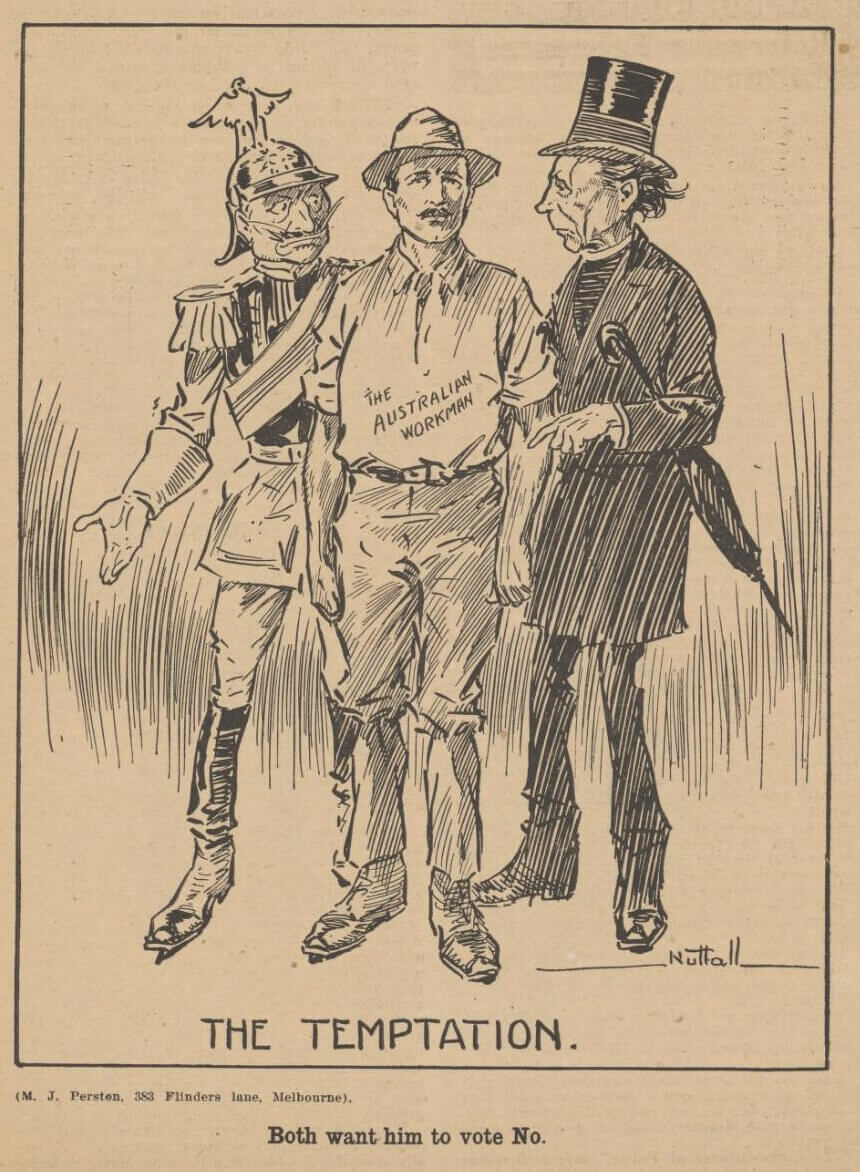
Another Charles Nuttall cartoon presenting 'The Australian Workman' in danger of being led astray by Catholic Archbishop Mannix on his left and the Kaiser on his right. The sub-text reads 'Both want him to vote No.' The cartoon assumes that working men were likely to oppose conscription.
Drawn by Charles Nuttall
Comment and Cartoons, 21 December 1917
Courtesy National Library of Australia
Sinn Feinism For Australia
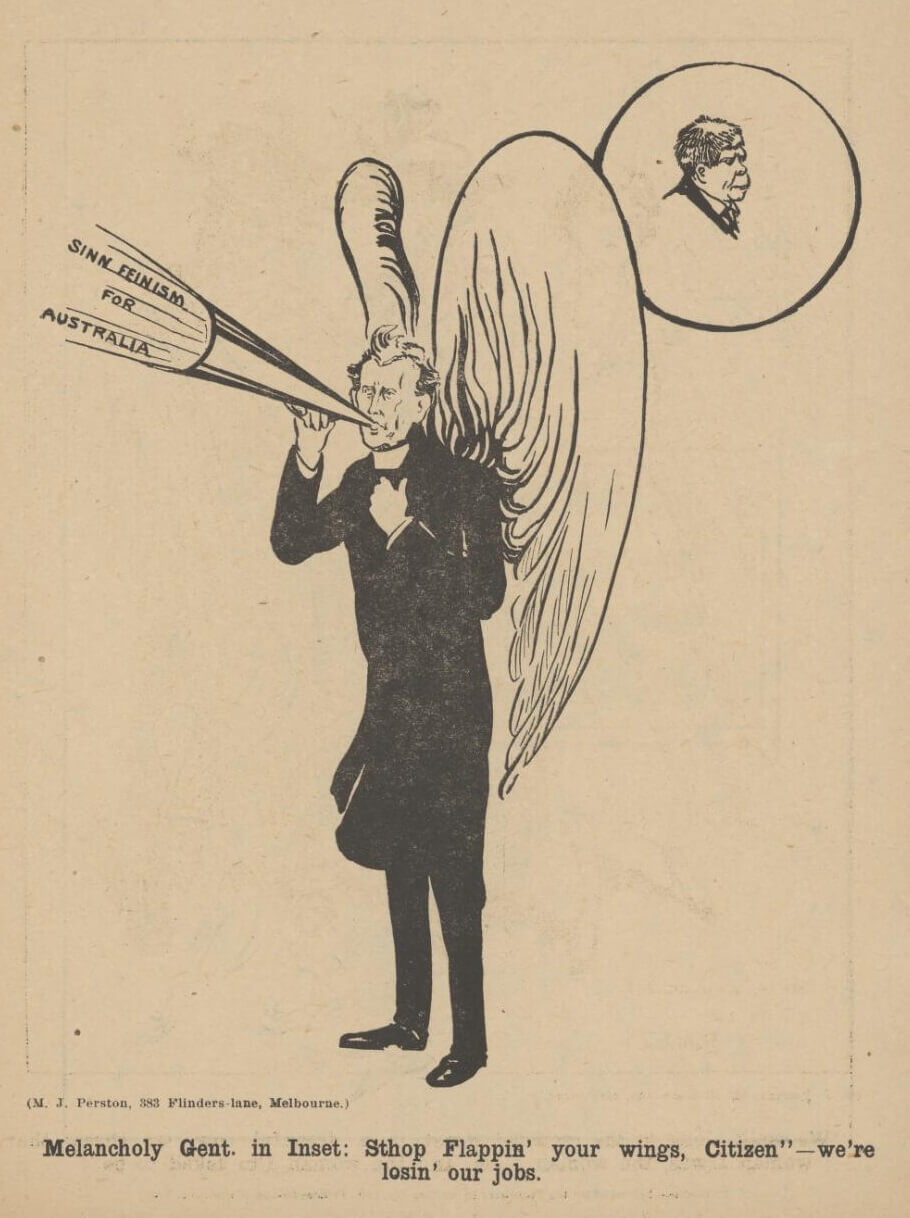
Catholic Archbishop Daniel Mannix is presented here as an angel of doom, with 'Sinn Feinism for Australia' issuing from his trumpet. In an inset behind him one of his fellow-Irishmen ('Melancholy Gent.') complains: 'Sthop Flappin' your wings Citizen -we're losin' our jobs.' The subtext may imply that employers were discriminating against Irishmen, or that this might follow if the Irish were tainted by 'Sinn Feinism'. Sinn Fein was the Irish Nationalist Party in Ireland. Ironically Mannix had not supported the Irish Nationalist cause in Ireland. The term 'Citizen' applied to Mannix referenced the title used for supporters of the revolution in late-eighteenth century France.
Artist unknown
Comment and Cartoons, 14 December 1917
Courtesy National Library of Australia
The Careless Smoker
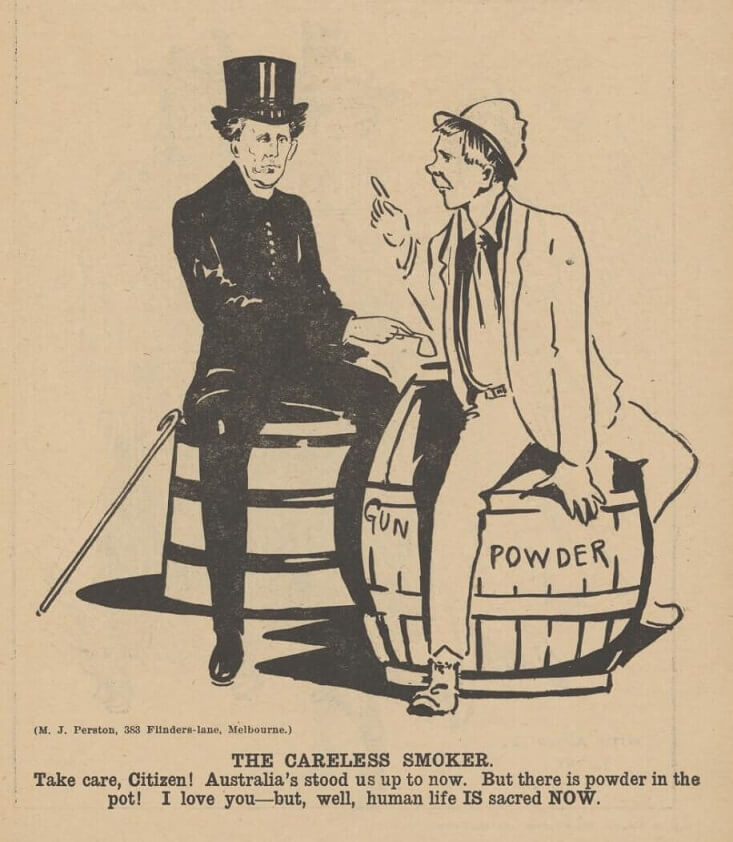
Daniel Mannix and a follower (fellow anti-conscriptionist or Catholic) are both seated on barrels of 'Gun Powder'. Mannix is knocking his pipe out on one of the barrels. He is admonished by his supporter: 'Take care, Citizen! Australia's stood us up to now. But there is powder in the pot! I love you - but, well, human life IS sacred NOW.' The cartoon may be meant to refer to rising sectarianism that might ignite into violence, or to the explosive danger of Irish nationalism. It might equally be intending to link the anti-conscription cause with socialism, or Bolshevism, as in revolutionary Russia. The 'sanctity of human life' was a common rallying point of the anti-war movement.
Artist unknown
Comment and Cartoons, 41 December 1917
Courtesy National Library of Australia
Old Blood Draw Propaganda Free to Use
Source: https://www.oldtreasurybuilding.org.au/propaganda-and-the-conscription-debate/
Post a Comment for "Old Blood Draw Propaganda Free to Use"